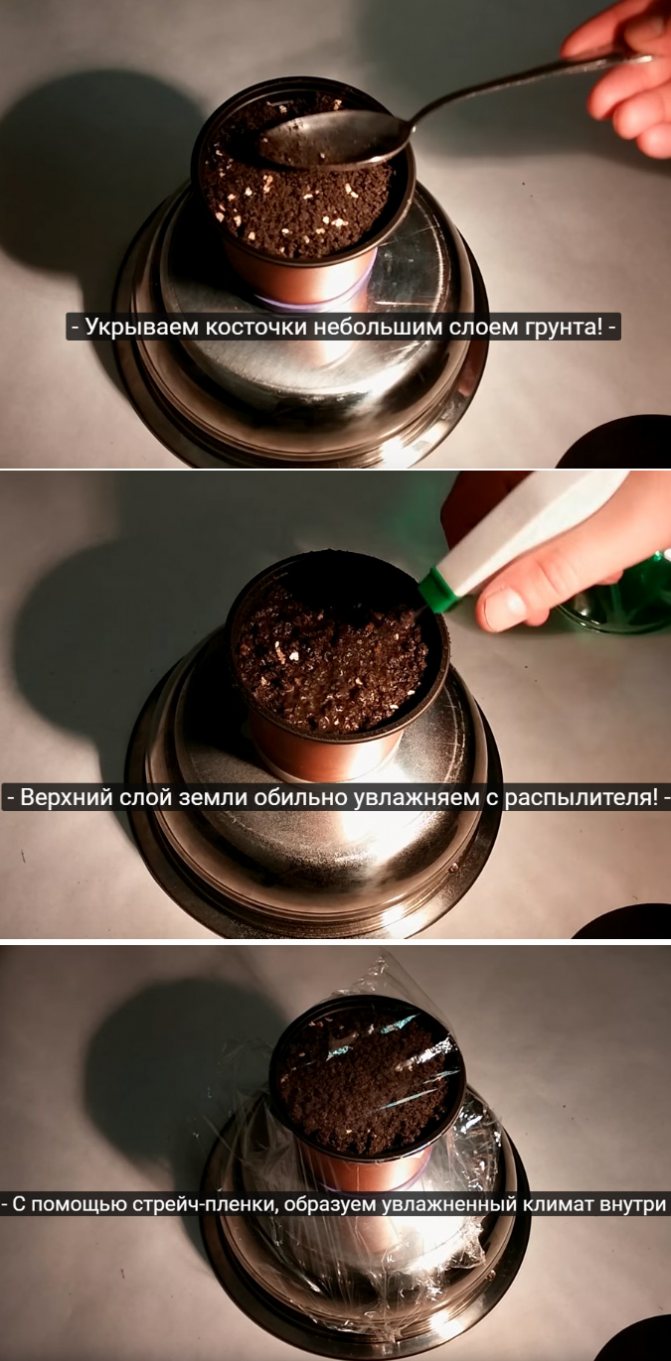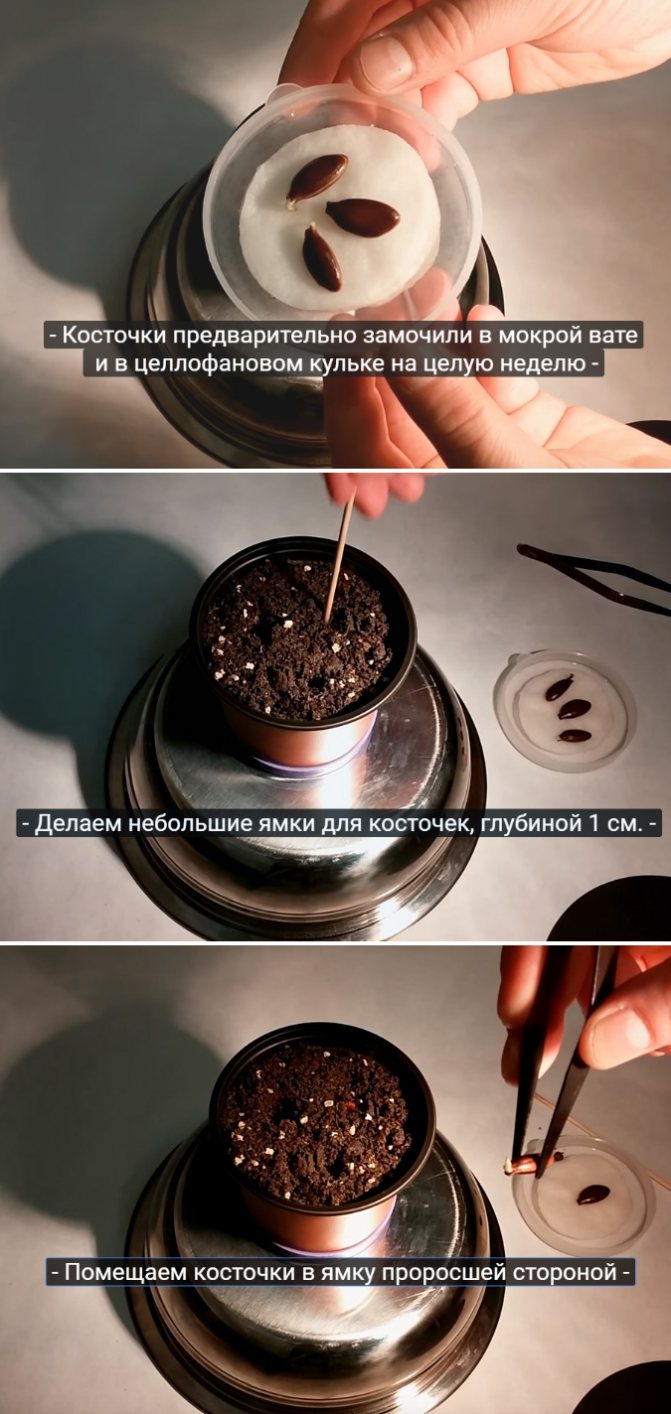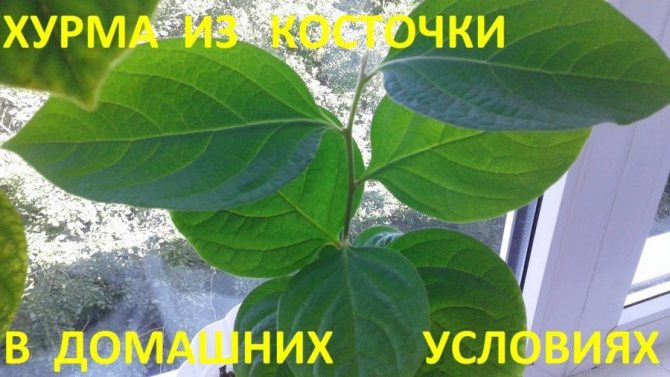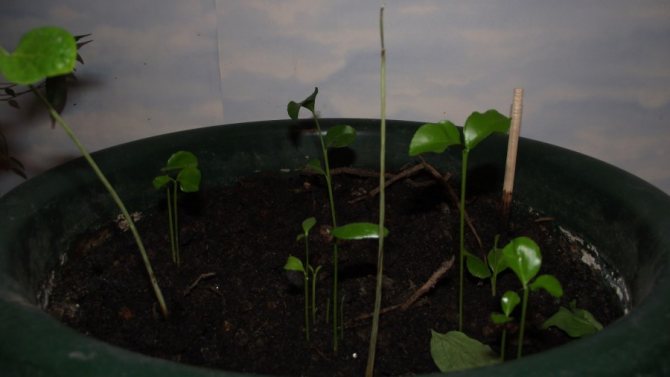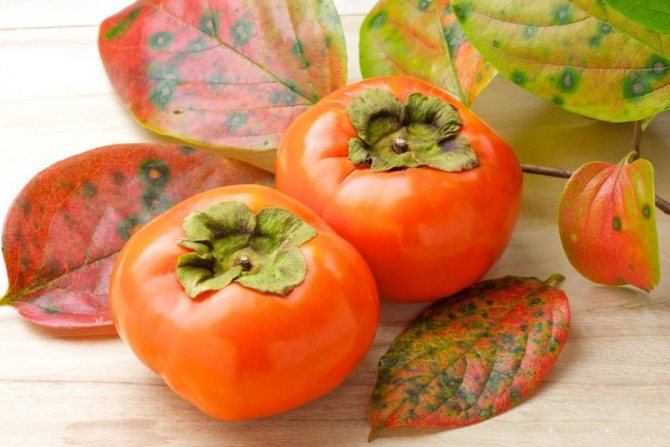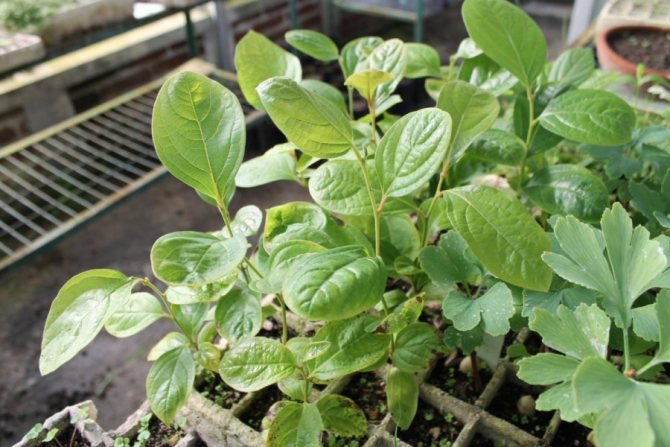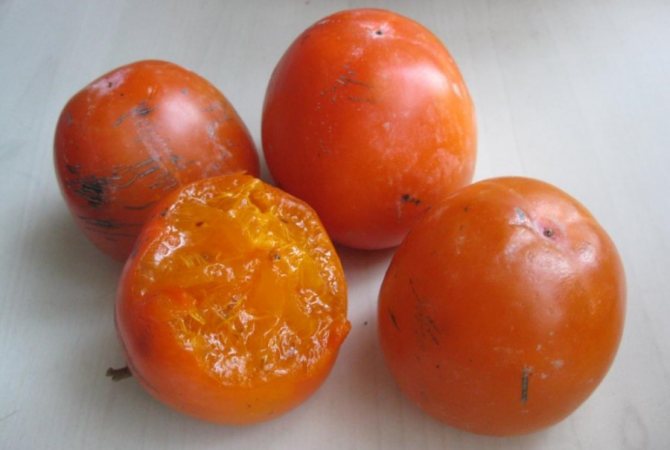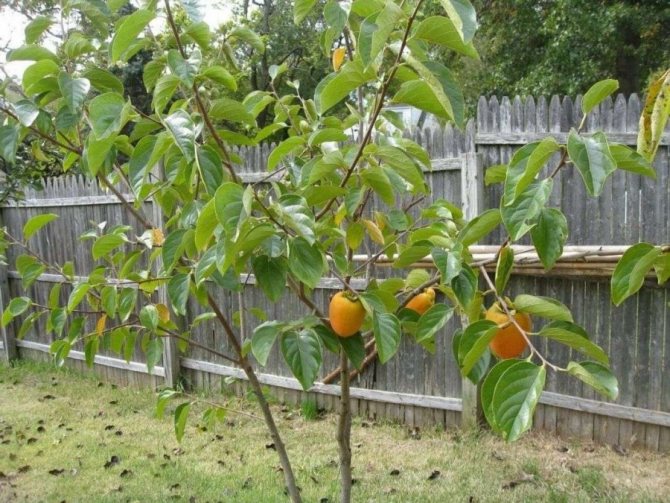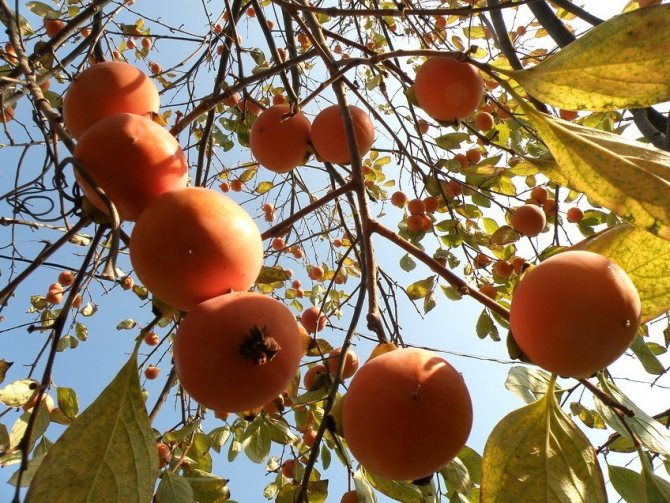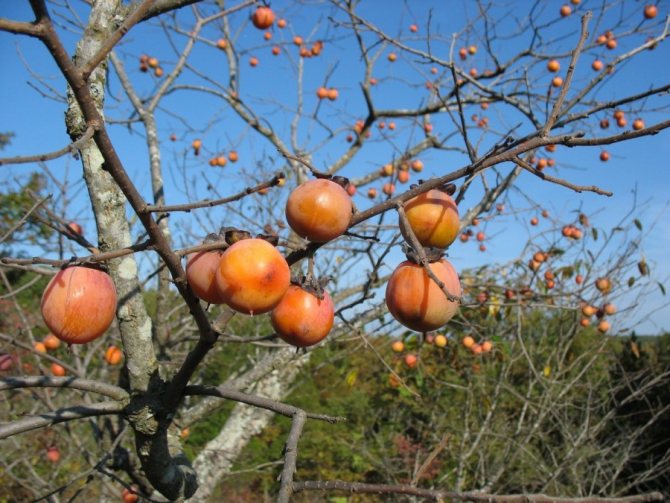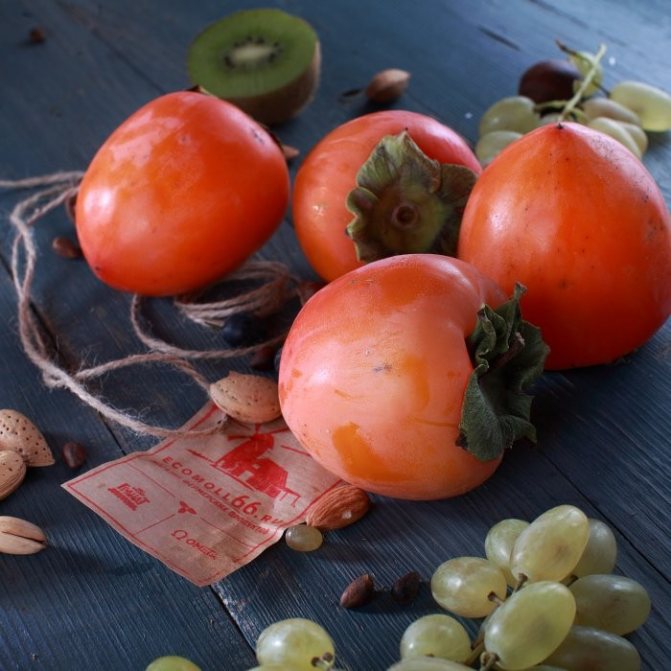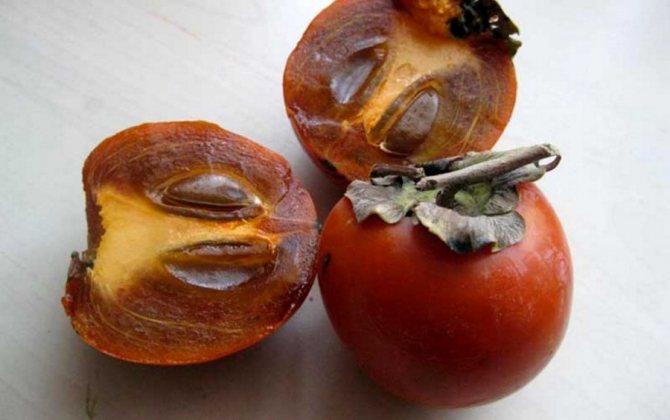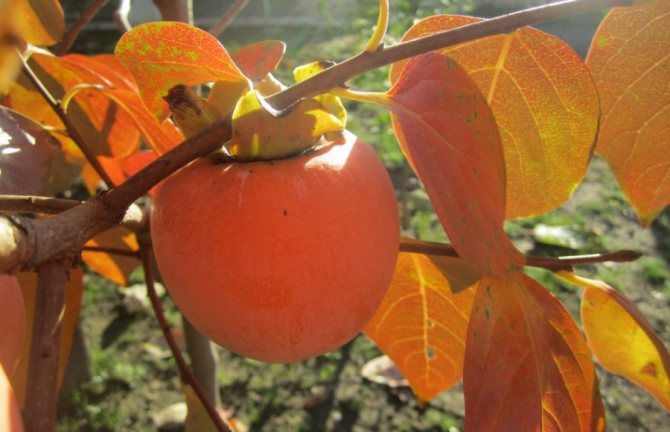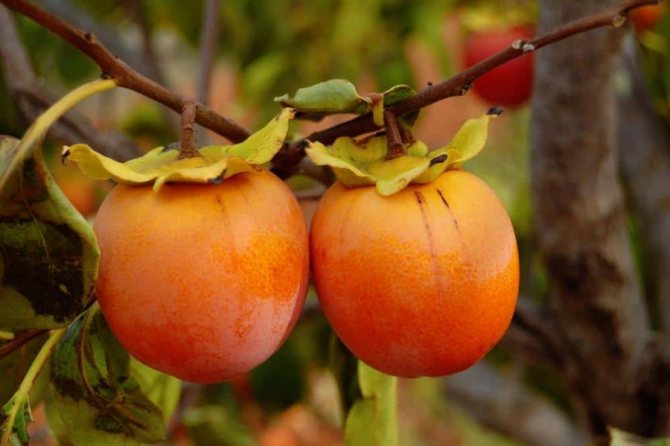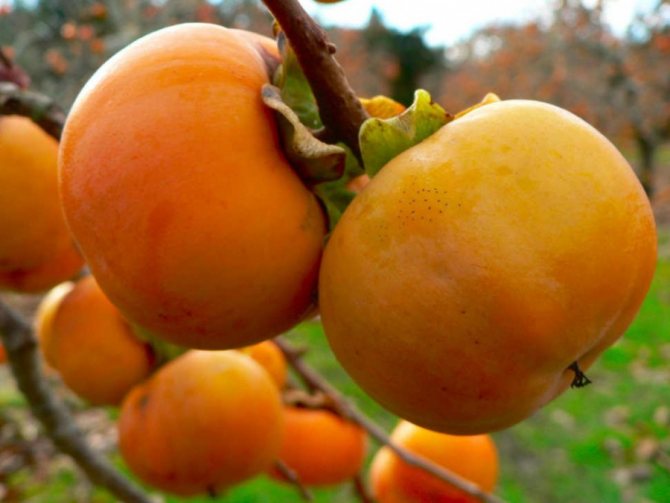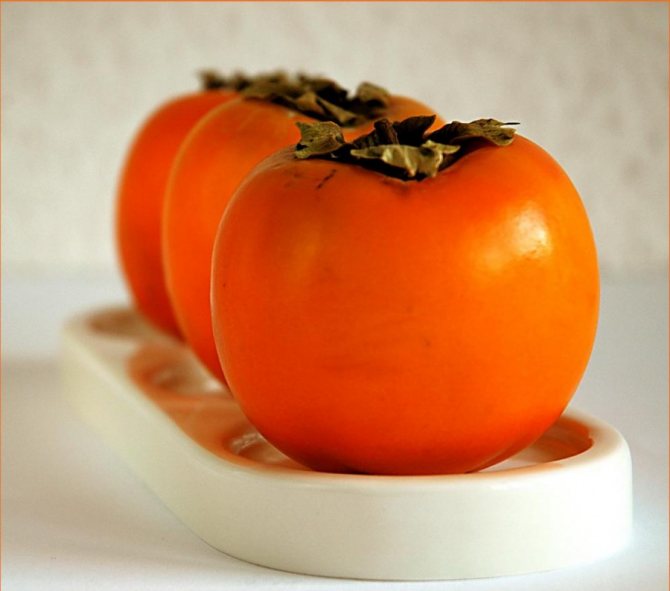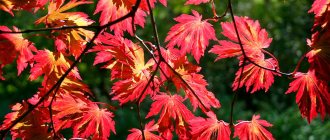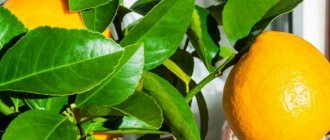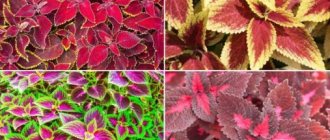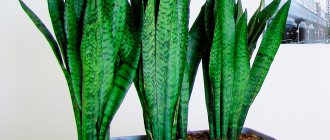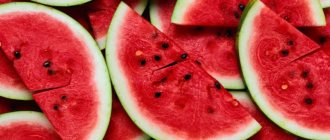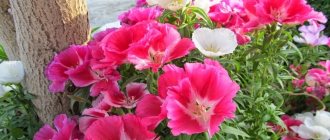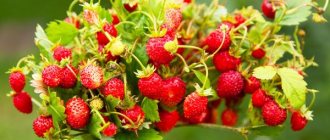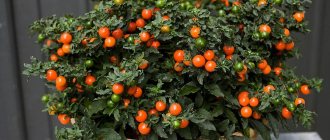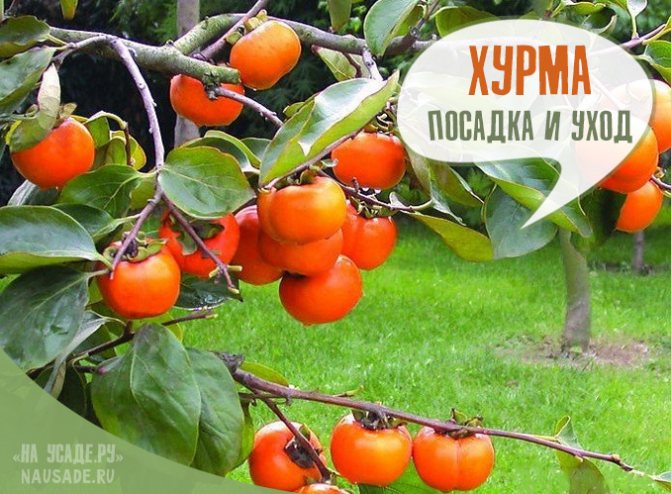
This plant has many names: in England it is called "persimon", the Greeks are sure that it is "food of the gods", in the east it is often called the date plum, in America it is known as "black pudding" or "sapota", in Asia it is " velvet apple ", mabolo, and in Russia the" kinglet "is especially popular. All this variety can be called with one short word - "persimmon". The berry is very rich in vitamins, read more about the beneficial properties of persimmon in the article >>
Purpose of vaccination
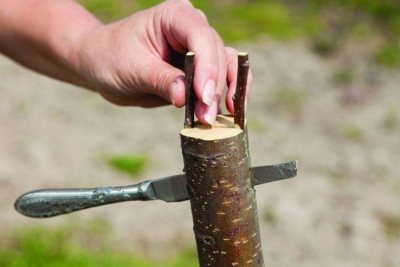

Grafting is a method of propagation of cultivated plants using only one cuttings or buds of the resulting specimen (scion) to another plant (stock). This allows you not to waste time and energy on growing plants from seeds and seeds, and also not to spend money on buying seedlings.
Experts believe that grafting persimmons is a more effective means of propagation than planting seedlings. In addition, several grafts can be planted on one rootstock and different varieties can be obtained on the same tree.
How persimmon grows
This tree is most often 5-7 m tall. But there are giants, such as the Caucasian persimmon, which can grow up to 30 m, and there are dwarfs, whose height is no more than 2 m. But they are all very light-loving, the crown of these trees is wide, spreading. Because of this, the tree looks larger than its actual size.


In general, it looks like a large apple or pear tree. The leaves are quite large, bright green in color. But the flowers are small, inconspicuous, greenish and almost invisible. The fruit is most often referred to as a fruit, although according to the classical definition of botanists it is, surprisingly, berry.
What are the fruits
The fruits are very diverse in color, shape and taste. They can be green, yellow, orange, raspberry red and almost black, smooth or pubescent, sweet, sour, tart, firm or soft, and the taste and color of the pulp can vary with the degree of ripeness and storage conditions.
Round or flattened, elongated or heart-shaped, the size of a grape or a good tomato, the fruits of this tree have long enjoyed consistent success. And not only because they are attractive and tasty, but also because they contain many useful trace elements.
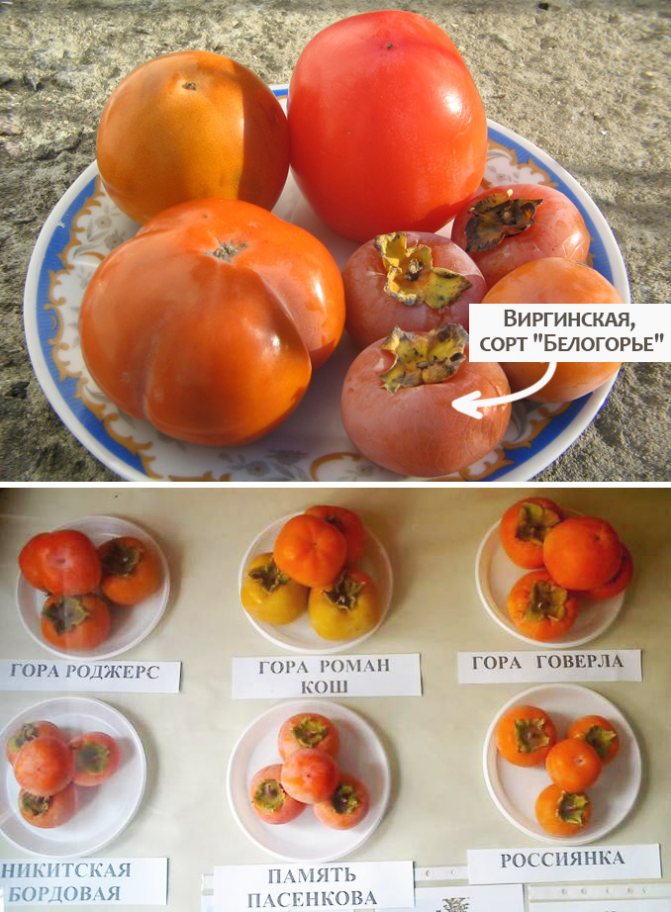

Few fruits and berries can compete with persimmon in terms of beta-carotene, ascorbic acid, and especially in iodine content.
How persimmon blooms
The flowers are small, greenish in color. Distinguish between male and female flowers. Sometimes flowers of a mixed type appear, but not every year and not on every plant. Moreover, on one tree there can be only one type of flowers, or maybe two, or all three. Therefore, in order to get the harvest, it makes sense if possible plant several seedlings.
It is believed that 1 male is enough for 6-8 female trees. Flowers are pollinated by bumblebees and bees, so it is very useful to plant nearby plants that bloom at the same time as persimmons to attract insects.
Fortunately, there are also self-pollinated varieties. Such a tree, even if there is only one for the whole district, will still bear fruit successfully. This plant begins to bloom in late spring or early summer. Much depends on the region, weather conditions and variety.


Does persimmon grow fast or slow?
It grows quite quickly, grafted varieties are more likely to bloom and bear fruit.Usually 4-5 years after planting, you can already see flowering in grafted seedlings, but plants grown from seeds bloom at best for 7-8 years.
What persimmon can withstand frost?
Of the variety of subspecies, persimmon is best suited for growing in harsh conditions. virgin... It is she who withstands a short-term drop in temperature to -30 ° C. Its fruits are small (like small apples or large apricots), but they taste very sweet.
In addition, this particular species is distinguished by its special plasticity and adaptability to new conditions. Virginia persimmon planting material can be purchased in specialized nurseries or from amateur gardeners. In addition, it is it that is used as a stock for more thermophilic varieties.
Tip: immediately plant virgin persimmon in a permanent place, as it does not tolerate transplanting well.
Will persimmons bear fruit from fruit bought in the market?
The seeds from the fruits that we usually buy from the market or from the store are not suitable for growing outdoors in regions with cold climates. Plants grown from them freeze under the root even at -15 ° C, not to mention more severe winters.
Naturally, there can be no question not only about fruiting, but even about flowering. Those who dream of growing just such a persimmon can be advised to grow it at home, indoors, or in a specialized greenhouse.
Is it obligatory to do it?
Grafting is the most popular persimmon propagation method. The flavoring properties of the fruits of the scion are already known, and the grafting allows you to transfer all the properties of the grafted plant. Using seedlings, the gardener always runs the risk of getting a "pig in a poke" when an unscrupulous seller gives out a completely different one for one variety, or the quality of the fruits will turn out to be completely different from what they were described.
Based on this, we can conclude that grafting is an optional method of propagation, however, it gives a healthier and more efficiently bearing plant in the future.
Fruit selection
Do not take pits from fruits with moldy sepals. A fungus has already settled on them.
Persimmons are often frozen for flavor enhancement. The bones in them die even after a short stay at sub-zero temperatures and become unsuitable for sowing.
You cannot take a bone from an unripe fruit. Unripe persimmons need to ripen - just like they do with tomatoes:
- The fruit is placed in a warm, dry place, for example, on a windowsill next to a radiator.
- Wait until the peel is cracked and the sepals are completely dry.
Then the bones can be removed. They should be heavy, full-bodied, fully ripe. To separate the weak, immature material, the bones are thrown into ordinary tap water. Floated ones are unsuitable for sowing.
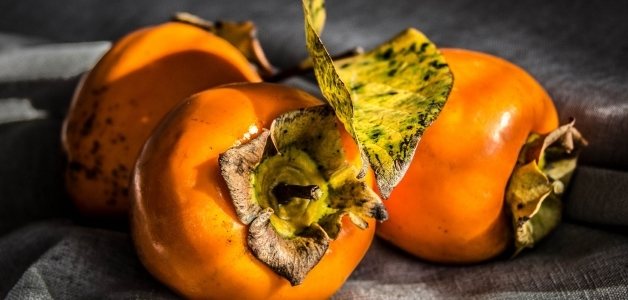

Will a seed-grown culture bear fruit without surgery?
The seeds obtained from persimmon are quite capable of further germination and fruiting of adult plants. This applies exclusively to non-hybrid varieties, since hybrids, even when pitted, are sterile.
In addition, there is no 100% guarantee that seed-grown trees will bear fruit or even live to the tree stage. From 10 seeds, 6-8 seeds germinate on average, 3-4 usually survive to the stage of a small seedling, and only 1 bone can subsequently grow to a large fruit-bearing tree. This is mainly due to violations of the conditions in which the seedlings are sown.
Persimmon is a very capricious plant in terms of seed propagation, and therefore grafting is a more reliable way of propagation.
How to grow a persimmon from a stone
It is very easy to grow a persimmon from a stone. It is much more difficult to save a young tree in the harsh conditions of central Russia.Therefore, for the northern regions, it is recommended to grow only frost-resistant persimmons from the stone, in particular, virgin. Subsequently, a large-fruited variety can be grafted onto such a seedling.
Those who live in more southern regions need not worry: if frosts are rare and do not fall below -10 ° C, the climate is humid and warm, spring comes early, and autumn is in no hurry, then you can grow almost any kind of persimmon.
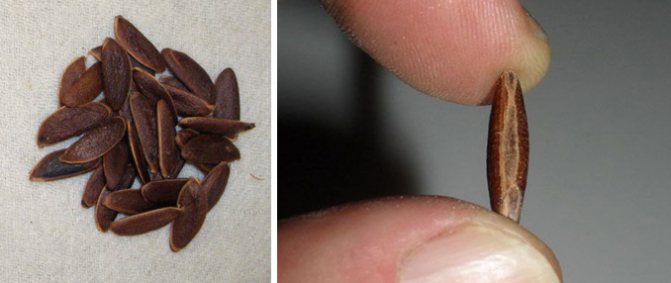

To do this, it is enough to remove the seeds from a ripe fruit (or better - several fruits), rinse in water, disinfect in a pink solution of manganese, plant in a light moist soil, cover with a film and wait for shoots.
Tip: do not take seeds from frozen fruits for planting, use only fresh ones, preferably ripe on a tree.
It is not recommended to plant persimmon seeds in the garden directly into the ground. For a start, it is better to germinate them at home, and when warm days come, gradually accustom the seedlings to outdoor conditions and only then plant them in a permanent place.


Choose an area that is sheltered from the wind and sufficiently lit. However, at first, be sure to shade the seedlings until they adapt. Do not forget that persimmon is a tree, the distance between seedlings should be at least 6 m for vigorous varieties and 3-4 m for less powerful ones. The landing pattern is arbitrary, but most often it is planted in a checkerboard pattern.
What is the difference between grafting a plant at home and outdoors?


Grafting persimmons growing in home or greenhouse conditions differs little from that of garden street plants.
Both the seedling and the scion must be of the same persimmon type: garden to garden, indoor or greenhouse - to the same.
An imbalance between the scion and rootstock will result in uneven bark growth in the grafted branch or bud, and the rootstock may not be able to cope with the scion's demands for nutrients and water.
Agrotechnics of homemade tomato tree - persimmons
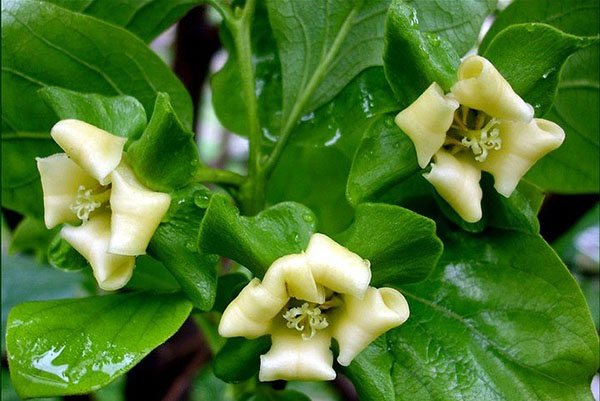

Growing persimmons at home is associated with the creation of "tropical" conditions for the plant. It means:
- A potted plant needs a lot of diffused light, in spring and autumn with additional lighting for 2-3 hours. Persimmon cannot stand direct sunlight; on a clear summer day, the window should be covered with gauze.
- In summer, the plant loves fresh air, but no wind, shaded.
- You need to water the tree in small portions, without creating stagnation and dirt in the box.
- Daily spraying on the leaves is required.
- During the rest period, the tree sheds its leaves and can be stored at temperatures up to - 150. Usually, +5 -10 degrees in a dark underground, with periodic moistening of the earth clod, is enough.
- During the growing season, moderate feeding, replanting or renewal of the upper layer of the substrate are required.
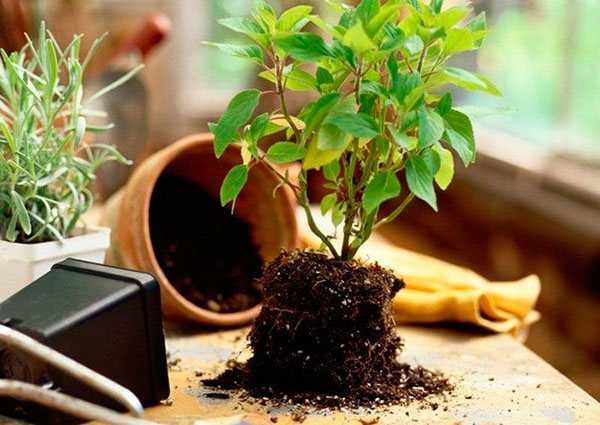

Home care for a persimmon from a stone to obtain a fruitful tree is associated with maintaining a balance of stressful conditions with favorable ones. This is how trees are forced to bear fruit in conditions unusual for them. Limited doses of fertilizers do not allow the vegetative mass to grow, otherwise the roots will not cope. On the other hand, artificial supplementary lighting and the absence of a draft is comfortable for persimmons. Regular crown formation inhibits the growth of the ground part and helps the roots.
How to water persimmon is a special science. If the tree stands in a bright room with a high temperature, the leaves dry out. It is necessary to water the plant with warm water more often, but do not create dirt in which there is no air, the roots are suffocating. Moderation is needed in everything. Watering cannot replace daily spraying, creating fog in the crown. Spraying on the leaves is carried out several times a day in hot weather. To increase the humidity, place an aquarium, saucer or tray with pebbles and wet moss near.
What can be a stock?
The best rootstock for persimmons are trees of the same genus - that is, persimmons of a different variety.One of the best rootstocks for other varieties is Caucasian persimmon, as it gives a strong root system that is resistant to weather conditions.
Attention. Amateur gardeners sometimes use citrus or fig seedlings as a rootstock, but such experiments are fraught with obtaining a non-fertile plant.
When grafting persimmons, it is necessary to observe the "deadline to deadline" rule - early-ripening varieties cannot be grafted to a late-ripening scion, since they differ in the growing season and resistance to environmental conditions.
Can I use an apple tree for this or not?
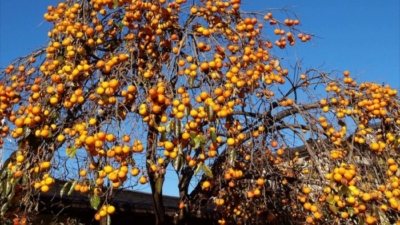

It is recommended to plant persimmons on a scion of the same kind, however, some gardeners go for tricks and use apple trees, plums, cherries, cherries as a rootstock.
As a result, less viable hybrids are most often obtained, at best giving only foliage or entering into flowering, but incapable of fertilization. Moreover, trees of different genera develop differently the bark and the trunk itselftherefore the stock may not be able to withstand the thickness and weight of the scion.
Favorable conditions for growing persimmons
There are several ways to propagate persimmons. This tree propagates both by seed and vegetative means, that is, by cuttings. We will go over both methods step by step. But first, let's get acquainted with what this tree loves most of all, what conditions suit it the most.
Soil requirements
Sufficiently fertile, loose and moisture-permeable soil is suitable for growing persimmons. Clay, swampy and saline areas are unsuitable for growing this tree. In the case when the soil is sandy, it makes sense to add fertile soil, compost and humus. On heavy black soil - make good drainage and add baking powder.
Ideal: turf and forest land. Excessively nutritious soil can cause vigorous plant growth, but the timing of flowering and fruiting will be postponed by several years.
Optimum humidity
Persimmon is a subtropical tree. In addition to heat, it needs moisture, and not only the root system, but also air. When watering, the water should not stagnate, and it is best to spray in the evenings and only with warm water.
Tip: it is not recommended to spray during flowering; it is better to put wide containers of water under the trees.
If your region has an arid climate, or the summer turned out to be without rain, the trees will have to pay special attention, often watering and loosening the ground. Can trunk circle to mulch... This will help maintain soil moisture and reduce the amount of watering.
Alternatively, you can sow green manure. For the winter, it is imperative to water the plant abundantly, this helps the tree to safely endure winter hardships and survive until spring.
Lighting
Like all southern plants, persimmon has a very long growing season and increased requirements for illumination: for its normal development, at least 2000 light hours per year are needed. You can find out the data for your region in a special reference book.
If there is a need for additional lighting, then you will have to plant persimmons in a partially heated greenhouse, create artificially necessary conditions. If a plant does not have enough light, for example, if it grows in an area where a dull shadow from a fence or building falls, then its leaves curl, and the fruits fall prematurely.
Temperature regime
In addition to light and moisture, persimmons need warmth. She feels best at a temperature of 28-30 ° C. In winter, the root system can withstand a drop in temperature to -8 ° C, frost-resistant varieties can survive even at -18 ° C, and only a few specimens can survive -27 ° C, while not only the roots, but also the crown most often suffer.
Therefore, no matter how frost-resistant the variety is, in regions where the thermometer drops below -10 ° C in winter, it is better to cover persimon growing in open ground.In nature, the most frost-resistant, virgin persimmon can withstand temperatures up to -28 ° C in winter.
Optimal timing for the procedure
Persimmons are grafted before the beginning of the flow of tree sap - in February-March, and sometimes in January during warm winters. Earlier or later grafting may fail, as the graft may dry out without receiving external nutrients.
When choosing the timing of the stock, you need to be guided by the weather conditions and the condition of the cuttings and seedlings. It is important that the cuttings for the scion are as freshly cut as possible., since an impermeable film is very quickly formed on the cut due to the connection of tree sap with oxygen.
Let's get down to the main question
Let's move on specifically to the topic of our article - how to grow a persimmon at home from a stone. This is quite realistic, the most important thing is to know the basic rules and adhere to them. First of all, you will need to create the necessary conditions. I must say right away that this plant is completely unpretentious and does not require special care. However, it does not tolerate cold weather at all, so if you live in a cool climate, you need to think about growing the tree in a greenhouse. You can grow it in the garden, but with the onset of cold weather, persimmon must be planted in a tub and brought into the house. Now let's move on directly to the cultivation technique.
All stages of the operation
Inventory
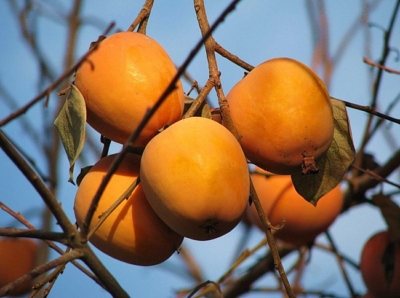

To plant persimmons using the splitting method, you will need:
- garden pitch;
- sharp knife;
- secateurs;
- insulating tape;
- screwdriver or wooden wedge.
For grafting with a kidney (budding), you need:
- budding knife;
- secateurs;
- garden pitch;
- polyethylene film;
- insulating tape.
Sequencing
For a similar plant
The grafting process differs only in methods - either by the splitting method, or by the kidney (budding).
- When using the splitting method, the stock is cut, cleaned of dirt or bark. It is desirable that the scion and rootstock be approximately the same thickness, but this is not a prerequisite.
- Next, the scion is split with a knife and a wooden spacer or screwdriver is inserted into it.
- The rootstock is cleaned of bark and cut in the form of a wedge. The cut length should be 3-4 times the diameter of the shoot.
- The prepared stalk is inserted with a wedge into the rootstock split so that their layers are connected.
- The vaccination site is wound with electrical tape or any other poorly stretched dense material.
- Slices of wood are coated with garden pitch.
Cropping and temperature control
Do not doubt whether it is possible to grow a persimmon at home from a stone. Of course you can, and many have already tried this method, it turned out to be quite successful. The tree must not be pruned before it reaches its optimum height. Then it is allowed to correct the crown by removing its height and width. By keeping the tree at this level, you can grow persimmons even in a small apartment. Find a place for her where there is very good lighting and the optimum temperature is maintained. It is highly desirable that there are no drafts, this tree does not like cold air extremely.
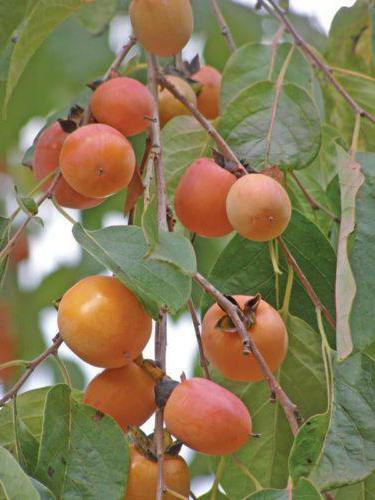

How to avoid mistakes and unpleasant consequences?
- Use of blunt instrumentation. It is important that all cutting tools are well sharpened as dull blades will unnecessarily traumatize wood and bark. The grafting process is comparable to a surgical operation performed with extremely sharp instruments. Blunt tooling compromises the integrity of the layers in the wood, which will greatly reduce the chances of the scion rooting in the rootstock.
- Vaccination too early or too late. Grafting must be done before sap flow in trees. Grafting too early will cause the stock to dry out by the time the scion wakes up, and too late to mold the stock.
- Late harness removed. It is important to loosen and remove the garter in time so that it does not cut into the bark and disrupt the flow of tree sap. Banning greatly inhibits both the grafting process itself and the further growth of the grafted cuttings
Vaccination is a delicate surgical botanical operation that requires certain knowledge and skills. It is best to graft persimmons on plants of the same genus, as this will provide the best survival rate for the scion. It is imperative to observe the grafting terms, use high-quality tools and do not forget about caring for the grafted plant.
If you find an error, please select a piece of text and press Ctrl + Enter.
It is difficult to get sprouts of exotic plants, the fruits of which have the most delicate taste and are famous for their beneficial properties. In this case, propagation of persimmons by cuttings is the easiest way to get seedlings.
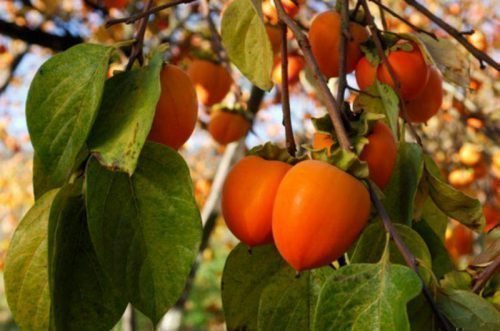

Requirements for sowing persimmons, care for seedlings
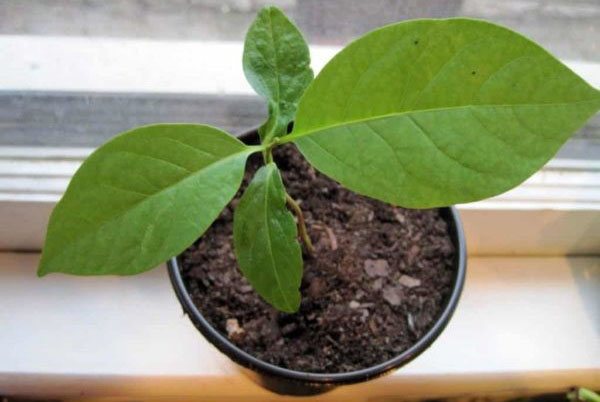

The soil for sowing seeds should be light and skinny. A mixture of sand and peat in equal proportions is suitable. At home, seed persimmons are germinated in a small container, covered from top to prevent evaporation. You cannot use a battery as a source of heat - the earth will dry out quickly. You need to build a mini-label. The sprouts are difficult to get rid of the halves of the seeds, you should help by moistening with a spray bottle and placing the pot in a polyethylene shell overnight. As soon as the seedlings give the first true leaves, they need to be planted, or left alone, the most powerful seedling. Transfer the plant to the prepared soil:
- meadow humus;
- peat;
- river sand.
To impart useful properties to the composition, you can add EM-1 Baikal to it, but only 2 weeks before planting.
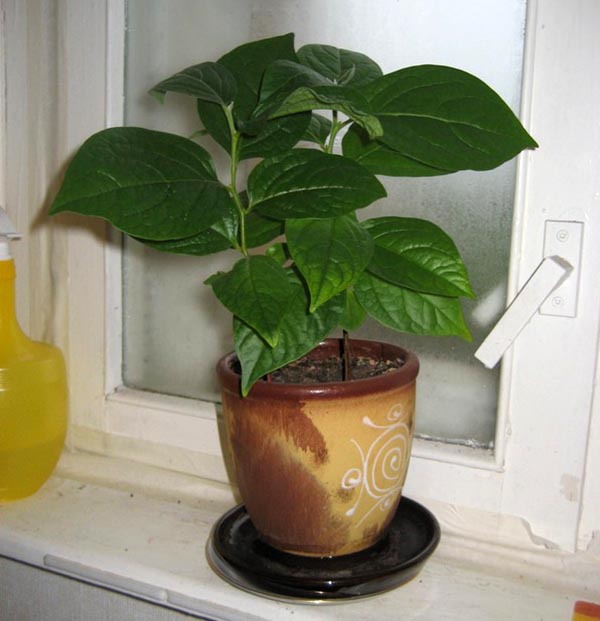

At home, growing persimmon from a stone without transplanting can be carried out up to 3 months. The seedling grows quickly, filling a small container with roots. Each next pot should be 3-4 cm larger than the previous one. It is no longer possible - the free earth will turn sour. From the moment the side branches are formed, the tree should be pinched so that the branches bush, and the crown turns out to be spherical.
Growing persimmon from stone as an ornamental plant is available from any fruit. But you can only get a crop from a grafted plant. Inoculate a persimmon with a small cuttings from a fruiting self-fertile tree. Such a scion can be taken in a botanical garden, in a nursery or from good friends. It is important that the tree is healthy. If grafted onto an annual seedling, fruiting can be expected in 5 years.
general description
Persimmon, as a fruit tree, is known in many countries of the world, it is grown because of the beneficial properties of fruits, as a decoration in the garden. Depending on the variety, and there are about 200 of them, the tree can reach up to 12 m in height. Persimmon is a perennial tree that can bloom for up to 500 years and belongs to the Ebony family, a class of dicotyledonous plants.
The leaves are dark green, glossy on the outside and matte on the bottom. The shape is oblong. The flowering period is from early May to mid-June, the tree has: male, female and mixed inflorescences, their shade is pale yellow. The fruits are sweet, fleshy with a tart, astringent pulp. The ripening period of the crop falls in mid-autumn.
Origin and types of plants
Persimmon is a tree that belongs to the Ebony family, or Blackwood. It first came into culture in China 2 thousand years ago. Then diospyros spread throughout the world. It was first brought to Japan and East Asia, then to America, Europe and Australia. Currently, thanks to the efforts of breeders, the apple of the east is grown not only in all warm regions, but also in northern latitudes. Under favorable conditions, the plant lives, actively bears fruit for more than one hundred years.
There are several types of diospyros, which differ from each other in size, frost resistance, as well as taste and color, size and ripening period of the fruit. Tall species have a trunk height of 25 to 10 m, undersized ones - 2.5-3 m. Early persimmons are harvested in August, berries of late varieties ripen at the beginning of winter.
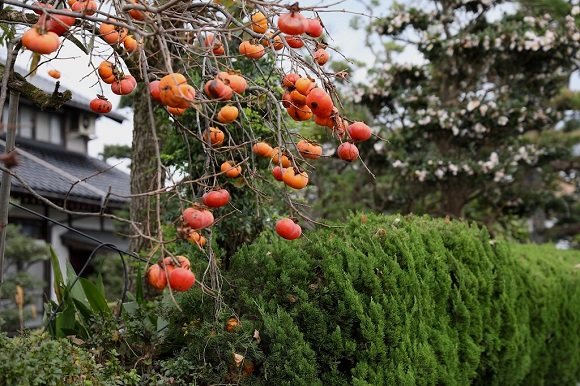

The fruits can be round, slightly elongated or flattened.
The fruits are round, elongated and flattened. The color of the peel varies from red-orange to bright yellow, the weight of the berries is from 70 g to 0.5 kg. Some varieties of persimmon, for example: Chinese, Egyptian, Chamomile, contain a lot of astringent substances, therefore, they are suitable for use only after freezing. Others (Korolek, Sharon, Oxheart) do not require additional processing.
Propagation by cuttings
Reproduction by green cuttings is carried out in June, when new shoots are actively blooming. To get seedlings from green twigs, you need to prepare a planting site:
- it is required to dig a hole, the depth of which is 50-60 cm, width is 90 cm: the length should correspond to the number of cuttings;
- drainage should be poured into the bottom of a trench or a specially prepared box in the form of sea pebbles or broken bricks;
- pour a layer of coarse sand;
- fill up to the top with a substrate from the soil, buckets of wood ash, 10 kg of humus and wood dust;
- watering with a solution of potassium permanganate as a disinfection;
- Pour coarse sand on top of the substrate with a layer of 5 cm.
Harvesting material for propagation by cuttings is carried out in the evening. Branch pruning is performed according to the criteria:
- necessarily the content of 3 internodes;
- there should be no lignification, the entire shoot is only green;
- cut the shoots with a straight cut from above and beveled to the side from below;
- between the cut and the kidneys, a distance of 1 cm is required.


After cutting, the shoots are placed in a growth stimulator for 12 hours. To do this, take the drug "Heteroauxin" in the amount of 3 tablets per 1 liter of water. The container with cuttings is removed in a cool, shaded place. Before planting in the ground, the shoots are washed with water, and then carefully inserted into the prepared place, 3 cm deep into the sand.
To create greenhouse conditions, the cuttings are covered with foil. Persimmons are watered every day, making sure not to overmoisten the substrate. The cuttings themselves are irrigated from a spray bottle 5 times during the day so that droplets do not roll off them. After 14 days, the covering over the greens is removed and fertilizer is applied in the form of liquid manure, 0.5 kg per 2.5 liters of water.
The next spring, you can replant the seedlings to a permanent place.
Selection and preparation of planting material
To plant a persimmon on your own, you need to correctly choose a fruit with seeds suitable for planting. When selecting, take into account that the Sharon, Mandarinnaya varieties do not have seeds, therefore, it will not be possible to obtain planting material from them. The fruit, the seeds of which are suitable for planting, should be with sepals without signs of mold, well ripened. Frozen persimmon seeds, as a rule, also sprout.
If the berry brought home is hard, it is placed in a warm place for several days. When the pulp of the persimmon becomes very soft, cut it, remove the seeds, then prepare them for planting in the following sequence:
- Rinse with warm water, thoroughly removing pulp fibers.
- For 2 days, immersed in a light pink solution of potassium permanganate for disinfection. Pop-up instances are thrown away.
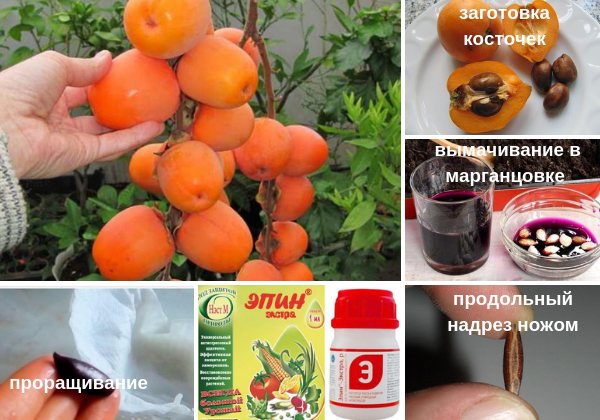

From seed to first harvest - Gently sand the edge of each seed with sandpaper so that they hatch faster.
- Prepare a solution of aloe juice (5 ml per 100 ml of water) or a growth stimulator (Immunocytophyte, Zircon, HB-101, Epin) according to the instructions.
- A cotton cloth or gauze is rolled several times and moistened abundantly in the resulting solution.
- The bones are placed between layers of cloth and placed in a cellophane bag.
- The bag is tied so that air remains in it, and placed to the radiator. After 7-10 days, the seeds should hatch.
You can germinate a persimmon seed in a simpler way by preparing a pot with a diameter of 10-12 cm and filling it with a mixture of garden soil, humus, peat and sand. See instructions in the picture.


Growing instructions
The seed soaked in potassium permanganate or Epin is buried 1.5 cm into the previously watered soil, sprinkled with loose earth on top.The planting is covered with a plastic bag or glass, placed in a warm, bright place. A sprout should appear in 10-14 days.
Grafting process
Grafting persimmons, like other fruit crops, requires special skills in plant growing. It is necessary to strictly adhere to all the rules and terms of the scion.
You can paint a persimmon on a tree of another variety, but such a plant will not last long, because the wood will develop unevenly. As a result, the appearance of the hybrid will resemble a thick tree with a thin stem.
Grafting of persimmon seedlings should be carried out on trees of the same species, then one can expect that the tree will bear fruit and develop normally. If you are going to plant persimmons on another variety of fruit trees, you will need to follow some rules.
- Grafting shoots only on plants of the same ripening period, late-ripening varieties are best suited for the stock.
- Trees must be climatically adapted: frost-resistant, drought-resistant.
Gardening Tips (Answers to Important Questions)
When does persimmon ripen?
Under natural conditions of growth, for example, in Abkhazia, it ripens in late autumn or even early winter. Much also depends on the variety. Distinguish between early, middle and late varieties. In central Russia, it makes sense to grow only early-maturing varieties. It so happens that in one region the same variety ripens earlier or later, much depends on the weather conditions.
Sometimes they harvest after the first frost so that the astringency disappears in the fruits. Therefore, the persimmon season is not only autumn but also winter. The fruits may fall off themselves as they ripen, but most often they stick tightly to the branches and must be picked by hand.
Why doesn't persimmon bear fruit?
Persimon does not bear fruit for several reasons:
- A tree with only female or only male flowers grows on the site.
- The plant is overfed with nitrogen fertilizers or grows on soil that is too greasy and rich in humus.
- The tree is not sufficiently insulated for the autumn-winter period and the flower buds freeze out.
Why does persimmon shed fruit?
Fruits fall off prematurely if:
- A suitable pollinator does not grow on the site.
- The cultivation technique is not followed: the tree does not have enough light, moisture or nutrition.
- If the plant gets sick or is attacked by pests, then the ovaries also fall off.
- Sudden changes in temperature can also cause fruit to fall off.
Why do leaves curl and dry?
- Excessive or insufficient watering. With excessive moisture on the roots of the plant, root rot and other diseases can develop. If insufficient, the required amount of nutrients is not supplied to the leaves and therefore they twist.
- In insufficient light, the leaves also curl up and fall off.
- Lack of trace elements in the soil.
How to store persimmon so that it ripens?
It often happens that you have to harvest a crop that is not yet ripe. Persimmon is perfectly stored and ripened if placed in a cool dry (not lower than 0 ° C and not higher than 3-5 ° C) room, which is well ventilated. In such conditions, it can be stored for several months.
Tip: choose only undamaged fruits for long-term storage, without spots and cracks.
- To speed up the ripening process, bananas and other fruits that release ethylene can be placed next to the fruits of the persimmon, which contribute to the faster ripening of the fruit.
- In addition, storage at higher temperatures also has a beneficial effect on the ripening process of persimmons.
- Sometimes the liming method is used: green fruits are dipped for a couple of days in a 10% lime solution.
- Ripe fruits can be frozen, dried, or made into delicious preserves.
Where does persimmon grow?
Each subspecies and varieties have their own pros and cons, some trees can live and develop normally only in countries with a very warm, humid climate, and some can withstand frosty winters and can please residents of more severe climatic zones with a harvest.
Heat-loving varieties successfully grow and bear fruit on an industrial scale in the Crimea, Abkhazia, Georgia, Dagestan. The Krasnodar Territory is also quite a suitable region for growing this crop. By the way, persimmon can grow in Gelendzhik even without shelter. In the Caucasus and Uzbekistan, wild persimmon grows in almost every garden, whose fruits are small, but it is believed that they are very useful.
Every year this culture moves further and further north. Already now, many amateurs are successfully growing winter-hardy varieties in the Moscow region, in the Rostov region, as well as in the Volgograd, Belgorod, Chelyabinsk, Ryazan regions. For a long time and quite successfully persimmons have been grown in Ukraine, and recently even in Belarus.
Persimmon is a very plastic plant. Two identical seedlings of the same variety can show themselves in different ways. The plant is quite different from the pears and apple trees we are used to. Therefore, those gardeners who live in central Russia and set out to grow persimmons in their garden need to take into account some of the features of growing this culture in the open field.
Are there large-fruited frost-resistant varieties?
Of course, I really want the fruits to be large and more similar to those that we see on store shelves. Now hybrid varieties have already been obtained that combine the best qualities of virgin persimmon and oriental persimmon. The variety Rossiyanka can withstand frosts down to -26оС. And more recently, an amateur gardener from the Belgorod region, V. Evdokimov, bred a new frost-resistant variety, which he called Belogorye.
In addition, a very interesting variety bred in the Crimea, which is called Nikitskaya burgundy. As you can see in the photo, it stands out from the rest of the varieties for the size of the fruit and the color of the pulp. The fruits taste great, and an adult tree can withstand temperatures as low as -28 ° C.
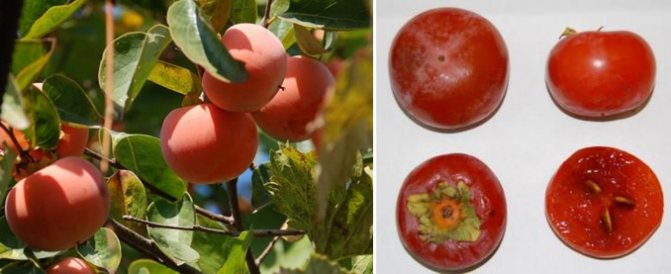

Therefore, we can say with confidence that persimmons, like many once strictly southern plants, are quite realistic to grow in their dachas even for residents of central Russia.
Despite the fact that persimmon begins to bear fruit quite early, it lives for a long time, bears fruit for more than 50 years. With good agricultural technology, correct crown formation and timely rejuvenating pruning - even longer. The yield from one large adult tree in the southern regions can reach 200 kg per season.
Cultivation of persimmons in the harsh conditions of central Russia, of course, is not an easy task, but very interesting and promising. None of the instructions can replace personal experience, but we hope that our tips will help you avoid major mistakes in growing persimmons.
If this culture is properly looked after, it will certainly thank you with delicious fruits. The hour is not far off when the food of the gods will grow in Siberia and the Urals, and not only in Sochi!
IMPORTANT! * when copying article materials, be sure to indicate an active link to the source:
If you liked the article - like it and leave your comment below. Your opinion is important to us!
Taking care of the tree
Correct and timely pruning of persimmons affects the further development and fruitfulness of a tree grafted or grown from a cuttings. Forming pruning is very important in the early stages of development.
They begin to form the crown when the seedling reaches 90 cm. The lateral shoots are cut, leaving 5 pieces of shoots forming the skeleton, including the grafted cutting, if any. In other years, cut off branches based on their size, all shoots above 30 cm are shortened to 15 cm.
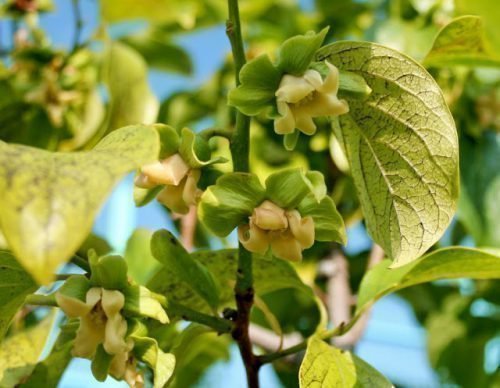

Pruning is also carried out to rejuvenate the crown. Cut dry, damaged, improperly growing branches.
What conditions and care are required for the plant
The homeland of persimmons is the tropics.This must be taken into account, because for normal development, seedlings require optimal or close conditions and competent care:
- Bright but diffused light for at least 8 hours daily. In most Russian regions, plants will have to be supplemented with conventional fluorescent or special phytolamps. Burns quickly appear on the leaves under direct rays.
- The most suitable temperature during active growing season is 25-27 ° C.
- Fresh air is good for persimmon in summer. It is recommended to "relocate" it to a balcony, veranda, terrace. But the plant must be protected from direct sunlight by placing it in a light partial shade.
- Persimmon does not tolerate either overdried or waterlogged soil. Water it sparingly, but often, constantly keeping the substrate in a slightly damp state. The plant responds very positively to daily spraying of the leaves. In hot weather, it is recommended to carry out even 2-3 times a day. Water is used warm, settled.
- Persimmon is very fond of high humidity. In addition to daily spraying, it is recommended to create a “company” for her from other plants, put a special air humidifier in the room or put wet moss, expanded clay in the pan of the pot.
- Persimmon reacts negatively to abundant feeding. Macronutrients (nitrogen, phosphorus, potassium) should be in the composition in minimum quantities. She categorically does not tolerate organic matter. It is advisable to use fertilizers based on humates or complex fertilizing with microelements, reducing their concentration in the solution by 1.5 times compared with the one recommended by the manufacturer. Top dressing is applied monthly, with the exception of the dormant period.
- Pruning begins when the tree reaches the desired height. Pinch the top, limiting growth. Then the lateral shoots are shortened by 2-3 buds, stimulating the branching process. Remove all branches that are knocked out of the correct contour of the crown, growing downward and inward.
- The plant needs a dormant period. This is a necessary condition for flowering. It signals its beginning by the falling of the leaves. At this time, persimmons are transferred to a bright place with a temperature of 8-10 ° C, watering is reduced and not fed.
It is not difficult to grow persimmons on a windowsill if you find high-quality planting material. This is a rather lengthy process, taking into account the preliminary preparation that is required for the bones. But in the end you will get a very decorative and sometimes fruiting tree.
The stages of the breeding process
To get a new tree, you need a well-ripened stalk, always from an already fruiting tree. It is not worth buying shoots from spontaneous markets or horticultural stores. It is better to ask a neighbor who already has a tree with fruits in the garden. The principle of planting and growing a plant both outdoors and at home is the same. The most suitable time for cutting cuttings is early spring, before the flow of sap begins.
Procurement of material
Each stalk must contain at least two eyes. All leaves are removed on the shoots. Cuttings are cut at a distance of 4-5 cm from the buds. All foliage, which will take moisture from the future plant, is removed.
Features of germination
Cuttings can be planted both in spring and autumn. Rooting cuttings at home involves an autumn procedure. In spring, cuttings are planted in open ground in the garden after the threat of the last frost has passed.
To germinate the harvested material, you will need a nutrient mixture and seedling boxes or volumetric pots. A layer of expanded clay (2-3 cm) or some other drainage material - pebbles, crushed stone - is placed on the bottom of the container. Then sprinkle with a nutrient mixture (garden soil plus humus in a ratio of 1: 3). Cuttings are planted in it and slightly trampled.
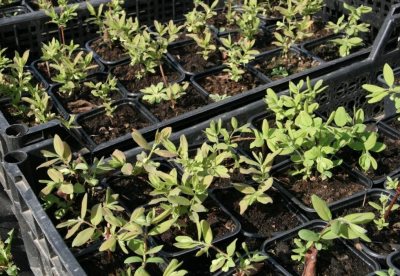

Further care of the cuttings is to ensure regular watering by means of irrigation from a spray bottle.Planting is placed in a place well-lit by the sun with the possibility of shading at noon. To accelerate the growth of roots and the process of building up green mass will help mineral and organic dressings, which are applied in turn - 2 times a month. The optimum temperature for keeping seedlings is 20-24 ° C.
The fact that the shoots have taken root will be evidenced by young leaves that have appeared with the arrival of spring. Such a plant can be domesticated or planted on a site. The best varieties for home growing are Hyakume, Jiro, Chinebuli and Zenjiaru.
Transfer to the site
In the southern regions, young plants are transplanted into open ground with the onset of stable spring heat. In the regions of the middle lane, cuttings are planted in early autumn, so that the plant has time to take root before the onset of the first frost. The optimal dates are early or mid-September.
When planting, it is worth choosing a place on the south side of the house, where there are no drafts, since persimmon is a sun-loving plant.
They dig a hole 30 cm deep and 40 cm wide. Drive in a peg for support. A mixture of garden soil and compost (humus) is poured onto the bottom, then sprinkled with a small layer of dug earth and the roots of the plant are laid on top of it. The root system is covered with earth, trampled and watered. 1 bucket of water is consumed per plant. The near-trunk circle is spud with rotted manure.
Newbie mistakes
Sometimes, even in comfortable conditions, persimmon grows poorly and does not bear fruit. There are several reasons for this behavior:
- The seeds did not germinate. Most likely, they were planted too deep, the sprout did not have enough strength to hatch through the thick shell.
- The plant is overfed with organic matter. With a trimmed crown and a small space for roots, excess nutrients have nowhere to go, the tree trunk begins to suffer. Can this be avoided? Yes, if during the growing season you apply top dressing every 2 weeks, alternating organic matter and mineral fertilizers.
- No artificial pollination was carried out on persimmons with male and female flowers. In this case, the fruit will not set. Only diospyros, on which only female flowers are formed, will bear fruit without the intervention of the owner.
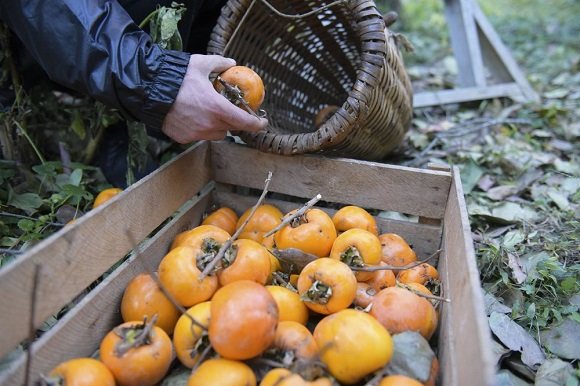

Garden harvest - The leaves on the plant began to swell and fall off. The reason is powdery mildew. The diseased tree should be sprayed with the fungicide several times.
- The apple of the east spent the winter in a room and did not bud in the spring. If you do not create stressful conditions for persimmon, in this case a low temperature, it spends strength only on building up green mass.
- After wintering in the cellar, mold appeared on the trunk. The room was poorly ventilated, so the bark was attacked by a fungus.
Knowing how to grow a tree from a seed that will delight the eye with beautiful flowers and juicy fruits, it is worth buying a ripe fruit and preparing its seeds for planting, and then organizing systematic care. Then the next portion of healthy home-grown fruits will definitely be provided to you.
Care rules
In the process of growth and development, young trees require proper and timely care.
- Throughout the growing season, the plant is periodically watered. The first moistening is carried out in early spring, then watering is carried out before and after flowering. This culture is also moistened during the period of ovary formation, which has a beneficial effect on the quality of the crop. The last watering is necessary in the fall - a month before the onset of cold weather.
- This culture responds well to feeding. In the second half of summer, the tree is fertilized with phosphorus-potassium preparations. At the end of summer, they are brought in by the foliar method. A solution is made of three components - potassium sulfate (0.5%), superphosphate (water extract 0.5-1.5%) and potassium permanganate (0.02-0.05%). Spraying is carried out every week with a gradual increase in concentration to the maximum value.
- Loosening increases soil aeration and improves oxygen access to the roots.This procedure is carried out 1-2 days after each watering.


The necessary preparation and procedure for planting the bone step by step
The seeds from the selected fruits are carefully washed, getting rid of the remnants of the pulp. To reject those that are definitely not germ-free, they are soaked in saline solution (two tablespoons per liter of water). A few minutes are enough for non-viable specimens to float to the surface.
Further, the seeds require stratification that imitates wintering in natural conditions. The process takes about 1.5–2 months - from mid-winter to early spring. The bones are mixed with wet peat chips or sand, placed in the refrigerator. After the specified time has elapsed for a week, they are placed in the warmest place in the apartment, closer to the battery, wrapped in a wet cloth and a napkin. It must be moistened as it dries.
The second stage of preparation is scarification. The dense shell is "scratched" with fine sandpaper, a file, or a nail file. Scrape the bones very gently along the sides and top. Or cut the shell with a scalpel, razor blade.
To accelerate germination and improve the immunity of future plants, seeds are soaked for several hours in ordinary water or in a solution of a biostimulant (purchased or natural). You can use the preparations Epin, Zircon, Heteroauxin, honey diluted with water, aloe juice, succinic acid. Next, the bones are disinfected by pickling for 15–20 minutes in a solution of any fungicide or potassium permanganate (pale pink).
Video: preparing persimmon seeds for planting
The seeds are planted in any container with a volume of about 0.3–0.5 liters. Persimmon does not need a nutritious substrate. In nature, it grows on almost bare stones. Any universal soil for indoor plants or peat mixed with sand, vermiculite, perlite in approximately equal proportions is suitable. To improve the qualitative composition of the soil, two weeks before planting, it can be spilled with a solution of any agent based on potassium humate, for example, Baikal-EM1.
The best time for planting persimmons is early spring. The procedure looks like this:
- Sterilize the selected container, for example, with boiling water. Fill the drainage with a layer of 2-3 cm at the bottom, then fill it with soil by about 3/4.
- Water the soil moderately, let the water soak.
- Plant the seeds, laying them horizontally, one by one or several pieces, deepening them by 2-3 cm. Sprinkle with soil (layer up to 1 cm), spray with water. Cover the top with glass, a plastic bag, or a cropped plastic bottle, creating a kind of greenhouse. You can place the containers in a mini home greenhouse.
- Transfer containers to a warm, dark (25-28 ° C) place. Provide bottom heating if possible. As the top layer dries, spray the soil with water at room temperature. Ventilate the greenhouse daily for 5-10 minutes. This will help prevent condensation and rot development.
- Persimmon seeds germinate for a month and a half. As soon as this happens, move the containers to the light. When the seedlings have full cotyledon leaves, remove the greenhouse. A part of the seed shell often remains at the top; it cannot be torn off so as not to damage the sprout. Spray the shell with warm water, after a couple of hours it will soften and it will be easy to remove it.
Persimmon, which has 3-4 pairs of true leaves (it takes 3-4 months to form), can be transplanted into a larger pot (7-9 cm) by transferring it. The soil is used the same as for seeds. Seedlings grow quite quickly, they need a transplant annually, in the spring. Adult specimens are transplanted less often, every 3 years. The diameter of the pot is increased slightly, by 3-4 cm.
Video: how to properly plant persimmon seeds and care for seedlings
Prevention of diseases and pests
This is a mandatory procedure, which is the key to the health of the plant and its future fruiting.To protect the tree from diseases, a week before flowering, the crown is sprayed with Topaz or Horus. Before the onset of cold weather, additional processing is carried out with a Bordeaux mixture of 1% concentration. Ailing trees are treated with insecticides and fungicides of systemic action - Bordeaux liquid or Karbofos is also suitable. Processing is carried out in early spring, 2 weeks after flowering and in late autumn after leaf fall.
From the invasion of pests, persimmons are irrigated with Karbofos, the soil is shed with Aktara. In case of parasite infestation, the crown and soil around the trunk circle are sprayed with Bordeaux mixture - 3 times with an interval of 10 days.
The process of proper planting in the ground
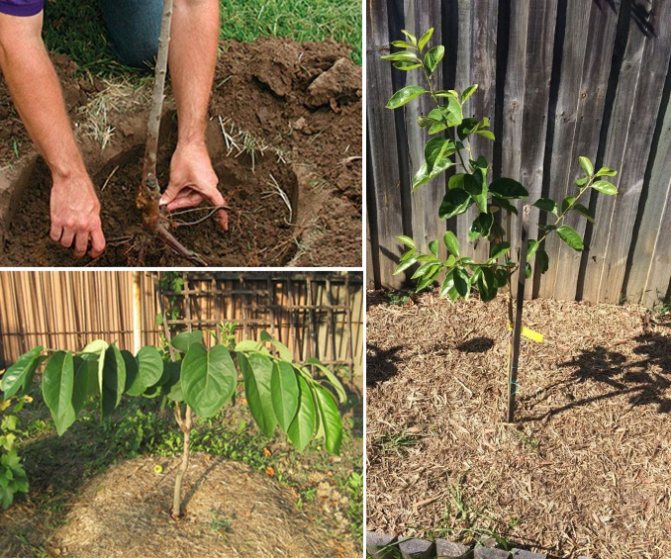

- First of all, we choose a suitable place: sunny, but not too open so that there are no drafts. Often planted under the protection of the wall of the house, so that subsequently the tree does not interfere with the building and is sufficiently illuminated.
- We prepare the planting hole as for an apple tree or a pear: at least 30x40 cm. Immediately drive a peg of sufficient height into the bottom. If necessary, we put drainage on the bottom, then the depth of the pit increases accordingly.
- On sandy soils, we apply more compost and sod land; on ordinary soils, half the rate is enough. At the bottom of the pit we pour a small mound of earth, on it we set a young plant there, fill it with prepared soil, slightly compact the earth and water it abundantly.
- If the planting of persimmons is carried out in the autumn, then with the threat of the first frost, we must cover the plant and mulch the trunk circle.
Persimmon pruning
As the experience of gardeners shows, the smaller the size of this plant, the higher its ability to survive. Trimming the central conductor is carried out at a height of 80 cm. This technique allows you to ensure balance between the aboveground and underground parts of the tree.


The main task of the gardener is the correct formation of the crown, which in the future will allow you to get not only a beautiful, but also a fruitful tree. For this culture, the sparse-tiered form is best suited, which implies a decrease in the height of the central trunk and the number of tiers:
- To stimulate the growth of skeletal branches, remove all shoots that thicken the crown. Branches that retard the growth of the central conductor are also subject to cutting. The main branch is pruned into a bud to stimulate its vertical growth. 2-3 skeletal branches are left on one tier. The optimal distance between them is 10 cm.
- Shoots of the second tier are left between the branches of the first row.
- The next year, the skeletal branches are trimmed - they are shortened by 40 cm.
- After the first fruiting, light pruning of the tree is carried out, leaving the annual shoots intact. After 1-2 years, fruits will appear on them.
- After the tree stops young growth, a rejuvenating haircut is performed for it. In the year of this operation, the tree does not bear fruit - all the strength is spent on recovery.
- Sanitary pruning of persimmons is carried out annually in early spring - all damaged, frozen and dried branches are removed.
Plant formation
Young seedlings are formed into young trees. At a level of 0.5 m, a small pinch is made for branching. At the same time, only a few shoots are left, and when they grow up, they are pinched. Branches of the second order are formed, they will need 2-3 pieces. Thus, you get a rounded tree with a height of about 1.5 meters. After about three years, you will have your first flowering and fruiting.
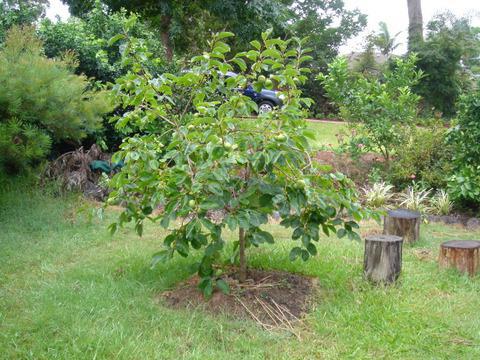

Persimmon grafting
The most effective way to achieve high yields from a tree is to graft persimmons. In addition, such manipulation makes it possible to diversify the fruits.
You can pinpoint persimmon to other types of culture - varieties Virginia, Caucasian, Fig or Ordinary.
Vaccination technique:
- a T-shaped incision is made on a rooted plant (rootstock);
- a freshly cut cutting (scion) is inserted into it;
- the places of the cuts are tightly pressed and wrapped with transparent film or electrical tape.
Usually, a plant that blooms and bears fruit is used as a scion. A stalk of another plant is grafted onto it, which has good immunity and a strong root system.
From one variety, you can get a completely new one. To do this, remove all skeletal branches on the tree, clean the cut points, make T-shaped cuts and insert 1-3 cuttings into each. The contact points are wrapped with electrical tape so that the binding material does not cut into the bark of the tree, otherwise the stalk will not receive nutrients from the mother plant and will dry out over time. The binding points are lubricated with garden varnish and left in this state for a month. The end of February or the beginning of March is the best time for this procedure.
After a month, you can watch the result - if the branches have not dried up and the first leaves have been released, the process was successful. Carefully remove the harness so as not to damage the graft bark. Further caring for a tree is no different from caring for a varietal plant.
Where to get persimmon seeds and how to prepare them?
Having bravely decided on such a bold experiment, you need to pick up high-quality fruits of bright color, without spots, dents, putrefactive lesions.
Important: persimmon bones that have been subjected to even short-term freezing are not suitable for planting.
The fruits are spread in a dry, warm place for ripening, which is determined by the cracked skin and dried sepals. Now you can remove the bones and subject them to further processing:
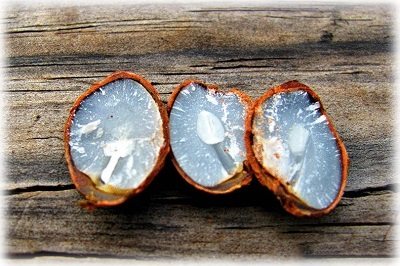

The seeds have a strong peel, through which it is sometimes difficult for sprouts to break through, experienced ones advise, before soaking, to make light cuts along the longitudinal sides, carefully removing the top layer of the peel.- First of all, the planting material is disinfected in a weak solution of potassium permanganate for at least 48 hours. The container is placed on the battery, placing a napkin under it, or in a warm place so that the temperature is 32-350C, so germination will occur faster.
- It is quite possible that several seeds will float up, they can be thrown away without regret, they will not give full seedlings.
In order for the persimmon from the stone to grow strong, they are treated with growth stimulants.
You can make from aloe juice (1 tsp per 100 g of water) or use an industrial biostimulant:
- a gauze napkin is moistened with a solution;
- full-weight bones are wrapped in it;
- placed in a plastic bag, tied, leaving air;
- sent to the bottom shelf of the refrigerator, where it should be 5-60C, for about 2 months;
- after stratification, the bag with bones is placed near the battery, exposed to heat for a week.
After such a long preparation, you can plant the bones in a flowerpot. For some gardeners, this procedure seems tedious, they immediately germinate the seeds in a pot, but such a planting does not give great guarantees for a good result.
The healing properties of persimmons
It will now be easy for you to grow persimmons, knowing all the secrets of planting and caring for it, but do you know all its healing properties and how this wonderful fruit acts on your body?
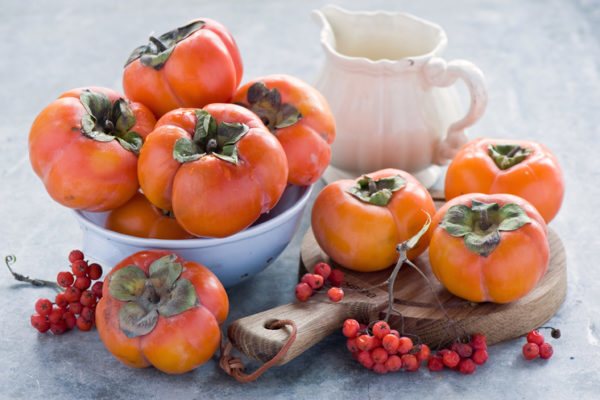

- One of the main substances found in persimmons is magnesium. And, as you know, magnesium is indispensable for hypertensive diseases.
- Vitamin PP is excellent for treating depression, with a weakened immune system.
- Carotene strengthens the cardiovascular system, improves vision and skin condition. Carotene is also known as an antioxidant that prevents cancer.
- Potassium is indispensable for the diet of athletes and improves brain activity. Promotes the proper functioning of all human organs.
- Glucose and sugar strengthen the heart muscle, vitamin C - the walls of blood vessels. In addition to these vitamins, persimmon has a low acidity, which is useful for the gastrointestinal tract.And if you are struggling with varicose veins, bleeding gums, problems with digestion, gastrointestinal tract, liver - persimmon is an irreplaceable product for you.
- For a cold, dilute persimmon juice in warm water and gargle three times a day - the disease will recede.
- For diarrhea, take persimmon tea every four hours.
- Persimmons are also useful for pregnant women. By including a couple of fruits a day in your diet, you can boost your immune system.
Persimmon has not only healing properties, but also quite effectively used in cosmetology, dietetics, has an anti-cellulite and anti-aging effect. And the healing properties of dried persimmon are no different from the properties of fresh ones.
Now you know how persimmon grows. By growing this tasty and healing berry at home, you will provide yourself and your family with vitamins for a long time. Indeed, with proper care, the persimmon tree will bring a big harvest every year, for many, many years in a row.
Crown shape
The growth of branches must be controlled so that the tree develops beautifully and neatly after transplanting. For this, trimming is carried out to give the shape of a ball.
When young seedlings have a height of 50 cm, start trimming. A secateurs are used to remove the tops. Get rid of the lateral branches. About five branches are retained.
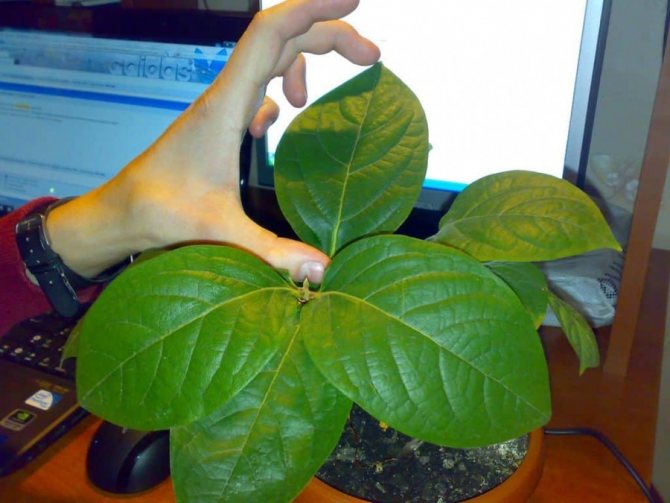

Watering
Greens should be regularly watered with water that has stood in an open container for at least 24 hours. Then the alkali and salt will get into a smaller volume.
The next watering is carried out with a new settled liquid. If possible, spring water, melt water or rain water is a good alternative.
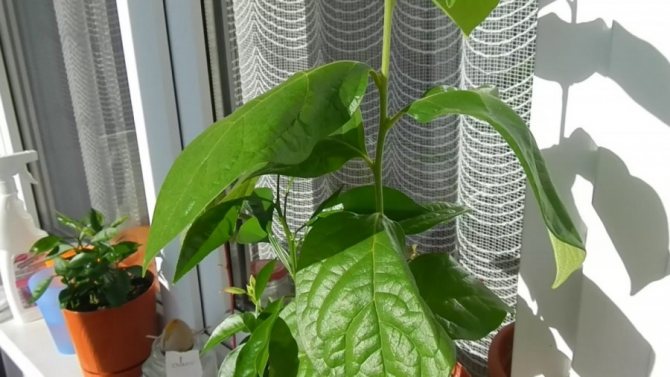

Moisten the soil slightly in summer. Too much flooding will kill the embryo, and the adult stem will disappear due to the decayed root.
Let's sum up
Considering all the nuances regarding the cultivation of a delicious fruit, beloved by all Russians, you can easily grow seedlings, which will gradually turn into a small, fruiting tree. After about 4 months, the seed will turn into a full-fledged plant, which will delight not only you, but also your family, friends and all guests. Having gained such valuable gardening experience, you can conduct similar experiments with other fruits, already knowing what nuances you need to attend to to create a comfortable atmosphere for a flower.
Soil preparation
For comfortable germination, achieve an airy planting mixture. You can buy ready-made planting material at a flower shop. The composition of the substrate includes equal parts of peat and sand.
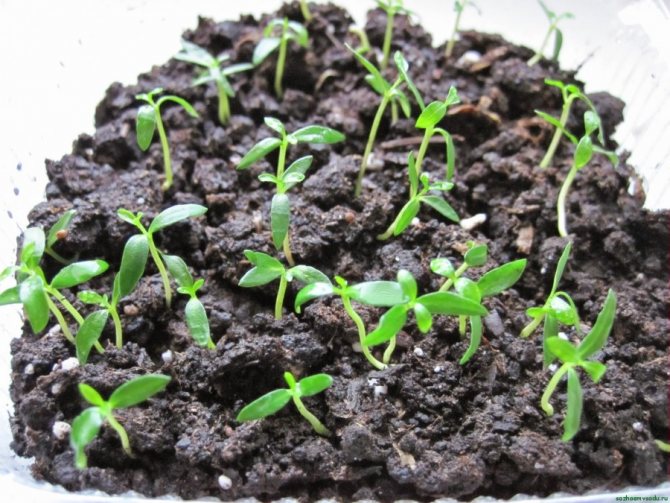

The soil is easy to make on your own by mixing the components. The addition of a fertilizer enriched with nutritional properties is allowed.
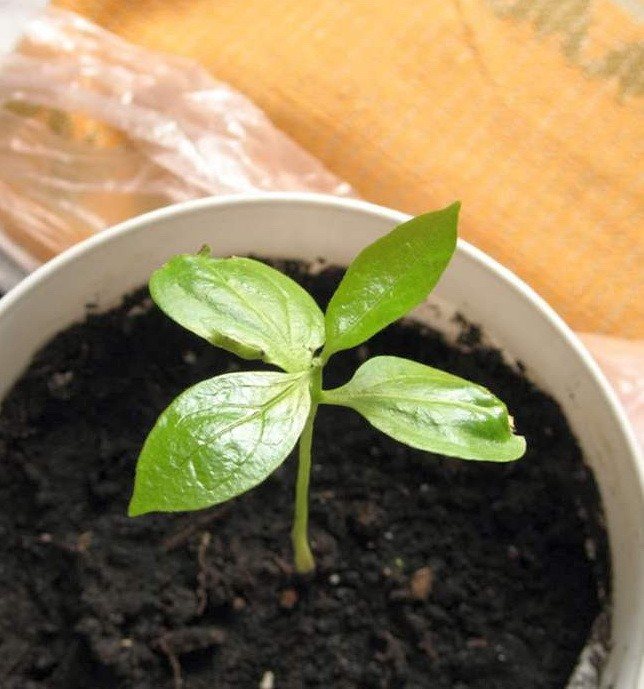

It is advisable to prepare the soil in advance so that the earth takes on room temperature and absorbs useful substances.
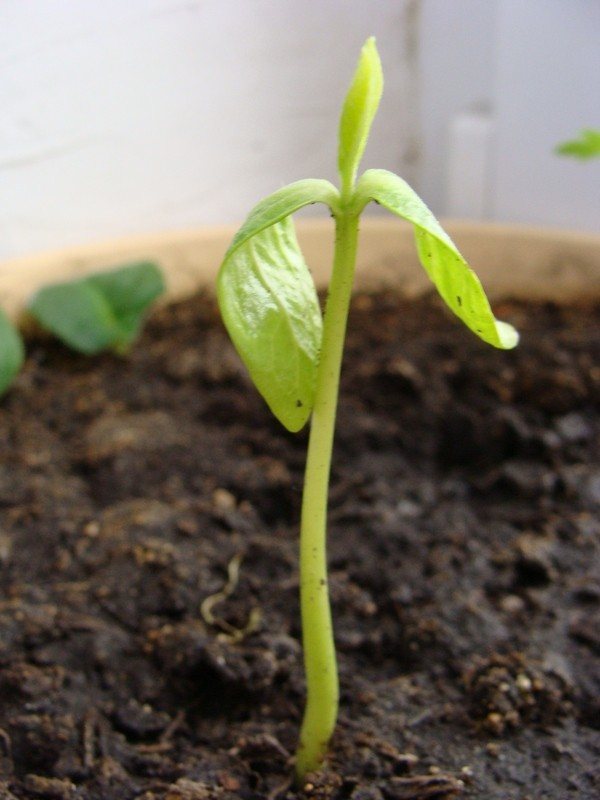

Persimmon varieties
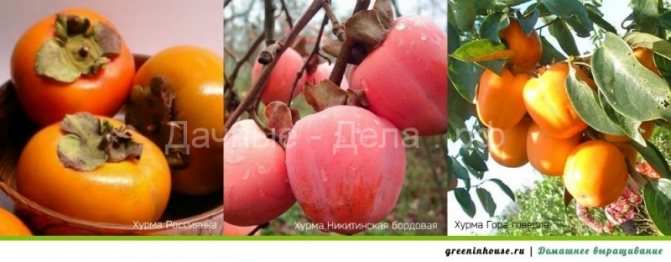

The most popular persimmon varieties in our country are:
- Fig (Chamomile) - when cut, it looks like a flower. Sweet, orange pulp
- Burgundy. The fruit is brown-orange, weighing up to 150-170 grams. The pulp is dark and fleshy. May be without seeds
- Russian woman. The fruit is medium in size, reaching up to 200 grams. Fruit color from pale orange to dark orange. The taste is delicate, but with a slight sugar content.
- Bull heart. Large fruit without seeds. The pulp is jelly-like, does not darken after cutting. Astringent taste.
- Mountain Hoverla. A plant obtained by crossing two types of persimmon. The most frost-resistant, suitable for our climate.
fruit trees
Formation of the crown of a tree
Young trees are pruned at a distance of 80-90 cm from the root collar. Lateral shoots are used to form skeletal branches, provided that the lowest one remains at a height of 50-60 cm from the root collar.
A year later, the skeletal branches are pruned again, about 35-40 cm. In the same season, the tree can give its first fruits, which means that further pruning should be suspended.The main purpose of pruning is the formation of new shoots, where the next year there will be a new fruit ovary. The so-called "sanitary" pruning of trees is carried out every season, but the "rejuvenating" one, that is, with the aim of increasing the yield, when a decrease in the growth of shoots really takes place, while this year the tree will not bear fruit.


How do I prepare the seeds?
You can grow plants from seed. The first step is to choose the right fruit itself, from which the gardener will take the planting material. For this, a fruit with good ripeness is taken. The main thing is not to freeze it and make sure that the skin is not damaged. It should reach maximum ripening in a place with a consistently warm temperature.
The fruit is taken only with fleshy pulp, which has not been kept in the refrigerator (freezer). The bones must be washed before preparing for planting under the tap
They are placed in a solution of potassium permanganate for disinfection, if they are not suitable for growing, then they float to the surface. After this natural selection, the seeds should be germinated before planting.
They are wrapped with a cloth napkin moistened with a bioregulator of growth or aloe plant juice, so it will be easier to grow. After that, they are laid out in a bowl and wrapped in plastic, put in the refrigerator for a month and a half. Remember: so that the napkin with the seeds does not dry out, it is necessary to water it with moisture from time to time so that they can then sprout.
Additionally, the bones are passed with sandpaper or a file to accelerate the germination process. The main thing in this business is accuracy, so as not to spoil the core.
Which variety is right for home conditions?
Persimmons were first cultivated in China. Now it is widespread, but few varieties are popular in domestic garden and summer cottages.
Chocolate or Korolek
The variety is characterized by round fruits with an orange surface. The pulp is colored chocolate. The berry contains 4-14 oblong seeds. Persimmon is characterized by juiciness, sweetness and lack of viscosity.
Honey or Mandarin
The fruit is similar to a tangerine, but only in shape. Its pulp has a honey flavor. The soft part is very sweet, colored in a bright orange hue. The fruit has no seeds at all.
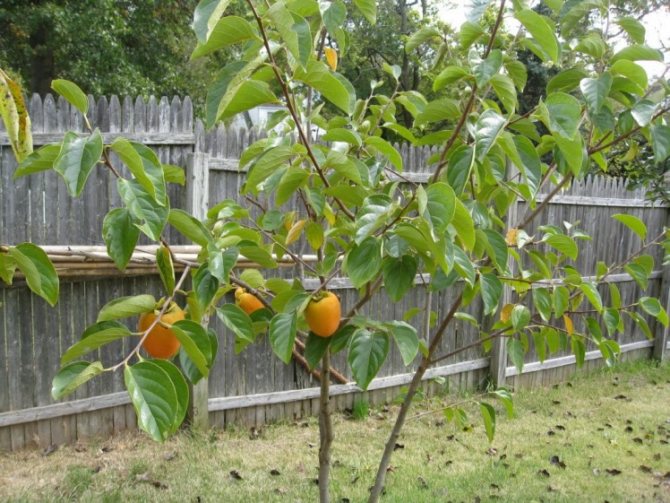

Tomato or Bull heart
There are no bones here either. The soft and tender persimmon looks like a large tomato.
Common persimmon
Unremarkable variety. Wild species may occur. Strongly knit mouth, light orange fruit.
Fig or Chamomile
Early maturing culture with brown flesh. The fruit contains several seeds. Very tasty, has a sweet taste. The main feature is an interesting shape, like a pumpkin.
Chinese persimmon
A specific fruit with a hard skin, not too sweet. It is characterized by a specific shape with a stripe.


Egyptian stretched persimmon
The variety is not very different from the Chinese one, but the shape of the fruit is neat and beautiful. The color is bright orange. It is not the best specimen to taste: it knits strongly, not very sweet, with a hard skin. It is better to choose sweet ripe fruits with pleasant taste for home cultivation.
Today, there are about 200 varieties of persimmon, differing in the size of the fruit part and taste.
Persimmon varieties
- Jiro (Jiro) - This sweet persimmon variety (up to 13% sugar) has flat-round fruits, grooves divide them into four parts from top to bottom. You can eat even unripe.
- Khachia (Hachiya) is a large self-pollinated variety weighing up to 300 grams. It is also called "bull heart". These fruits are conical in shape with a bright red color. They have a wonderful taste only after full ripening, since the sugar in them reaches 18%.
- Hyakume (Hayakume) - or Korolek, also a self-pollinated persimmon variety, vigorous. Fruits of medium weight - 250 grams, round.This variety is easy to distinguish as all fruits have concentric circles at the top. The fruits are considered ripe and edible when they turn brown. Sugar up to 17%.
- Zenjimaru (Zenjimaru) or chocolate bar. This self-pollinated variety is characterized by small fruits up to 100 g and a dark orange color on the outside and a chocolate shade of flesh. The taste is very pleasant. They have a lot of seeds - 5-8 pieces. You can even eat them unripe - still hard. Sugar content up to 15%.
- Tamopan (Tamopan) is the largest variety - up to 550 grams. Also self-pollinating and vigorous variety. Has a banner (cap) on top. Only edible when fully ripe.
Ebony - long-liver, persimmon, has other names - date plum, wild date, heartfruit.
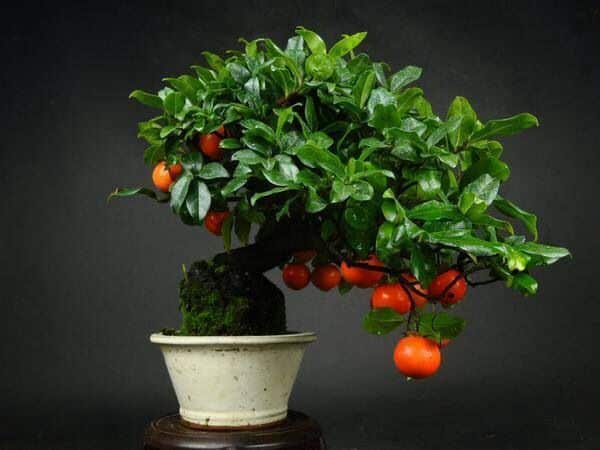

Could there be a pit persimmon potted crop? At home, cultivation of exotic plants is possible, but it is associated with the observance of a number of conditions. A tropical plant requires a special microclimate throughout the year. In winter, the plant sheds its leaves, requires rest and a low temperature. The fruits of the home tree are healthy. Self-pollinated varieties Khachia and Jiro - to help the gardener.
Transfer
When the first shoots with leaves appear, you can start planting persimmons in separate containers. The plants should be carefully removed without damaging the fragile roots and planted in a pot so that the roots occupy 2/3 of the total volume. If there is too much soil under the roots, rot may appear.
You may be interested in:
At first, young shoots should be covered, imitating a greenhouse. For this purpose, you can take any suitable jar. Remove it periodically, each time increasing the time so that the plant adapts to the environment.
An adult persimmon is transplanted at intervals of 3 to 4 years.
Persimmon types
There are countless types of persimmon - according to various sources, there are from 200 to 500.
In addition, breeders are constantly working on the development of new varieties of persimmon.
So, such persimmon is often found (when you click on the picture, it increases!):
Common persimmon (Caucasian - Diospyros Lotus) - differs in small fruits, only 1-2 cm in diameter, sweet and juicy, but not devoid of astringency - it disappears if the fruits are dried or held in the frost. The height of the Caucasian persimmon tree reaches 15-30m. As the tree ages, the bark begins to crumble. It blooms in the summer months (June-July) with small greenish flowers. The leaves of the tree are shiny, leathery, up to 15 cm long and 6 cm wide. The shape is oval, with a pointed end.
Eastern persimmon (Diospyros Kaki), also known as Chinese persimmon, Japanese persimmon, "Kinglet". It has yellow fleshy fruits, sometimes reaching a weight of 500 g!
Persimmon. Growing technologies. Planting, reproduction, grafting, watering, care
How to plant and grow persimmons. We propagate, plant, water the southern fruit, take care of it. (10+)
Agricultural machinery of southern fruit - persimmons
‘);
Table of Contents :: Search
Probably, each of you, if you have not tried it, then certainly saw the bright orange juicy fruits of persimmon on store shelves in late autumn and early winter. Today, gardeners have bred about 300 species of this winter fruit, but among such a huge variety, only three types of persimmon are most popular:
- eastern, or Japanese;
- Caucasian;
- virginian.
The agricultural technology of this culture is quite simple, and even a novice gardener - an amateur - can do it. In our latitudes, persimmons need to be grown in a tub, since they need to be harvested in winter. Therefore, you need to choose small varieties for growing. Persimmon for the summer can be taken out on the street, but you can generally grow at home (not to take out).
Productivity and varieties
The yield of this plant is very good. About 80 kg of fruit can be harvested from one ordinary tree. But the fruiting of some high-yielding varieties reaches more than 250 kilograms.


There are more than 200 varieties of persimmon.There are many different classifications and groups by which they are distinguished. For example, by taste; pollination; yield; early, middle or late ripeness.
For our area, the most popular such hybrids of varieties are: Korolek, Gora Goverla, Meader, John Rick, Nikitskaya Bordovaya, Rossiyanka, Gora Roman-Kosh and others.
Collection and storage of persimmon harvest
It is already possible to start harvesting the first crop in 4-5 years. Do not be upset if there is a lot of carrion under the trees. There will be less of it every year. The presence of a male tree will reduce the amount of carrion to a minimum. You can harvest the fruits from October to November. The main thing - do not tighten the collection until severe frosts
... With a plentiful harvest, you can put supports under the branches. Storage of persimmons grown outdoors is desirable in
cool place
... The storage area must be accessible in order to periodically check the condition of the fruit.
Persimmons can be frozen, dried - at the same time, they do not lose their vitamin value. The right approach to storage will help prolong the season of persimmons and the time to enjoy this healthy fruit.
Ringing features
In order for homemade persimmon to bear fruit, it is worth resorting to the method of ringing individual branches. The procedure is performed as follows:
- a strong branch is selected;
- at its base, perpendicular to the branches, a ring-shaped bark is removed with a sharp knife;
- the cut area is turned over and grafted onto the cut site;
- the place where the vaccination was made is wrapped with foil or electrical tape to avoid moisture loss.
A new cortical ring will form in a few weeks. This is the first signal of successful manipulation. In the future, the growth of the branch stops and the formation of fruit buds begins.
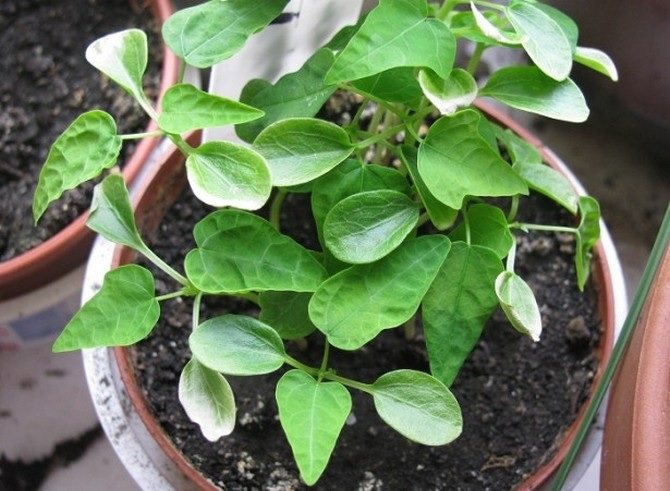

Germination
There are two more ways. After sanding with an emery tool, place the seeds on a piece of clean gauze or a wide bandage soaked in the solution. To do this, dilute 1 tsp in 100 grams of water. aloe juice.
Place the fabric in a bag and tie it to inflate while retaining air. Choose one of the kernel germination options:
- Keep the wrapped bundle for 2 months in the refrigerator at above-zero temperature up to 5 ° C.
- Mode for storing embryos up to + 40 ° C. Identify the packaging near the hot battery and monitor the contents - the grains may dry out or mold.
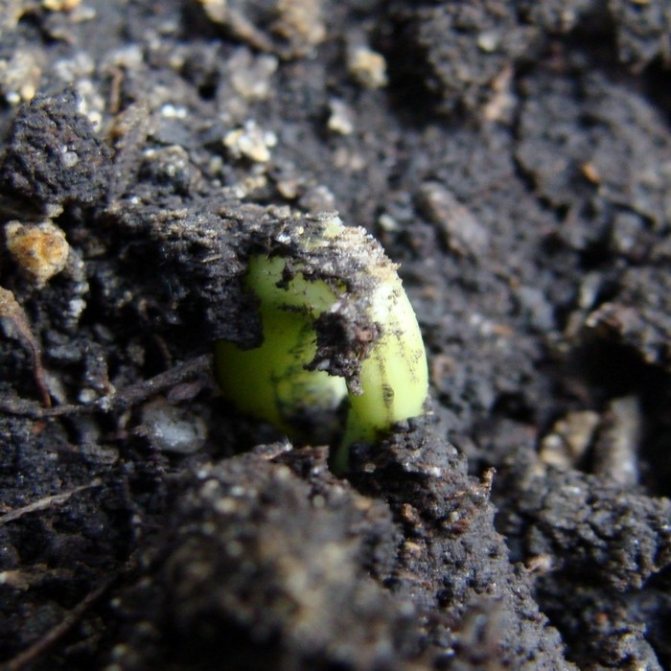

Growing persimmons from fresh seeds - where to start
To properly grow a berry tree at home or in the country, you need nutritious soil. The optimum soil is loose, fertilized, with a good soft structure and low acidity.
As a soil, you can take a sod layer with an admixture of vermiculite and sand.
The culture will take root only in a certain container - a ceramic pot with a diameter of at least 10 cm. The persimmon should be in it for the first growing years. Important! The culture is sensitive to stagnant water. To remove excess moisture, place pieces of earthenware on the bottom of the container, and cover the top with earth. If you choose the wrong soil or container, there is a risk of rotting of the root system.
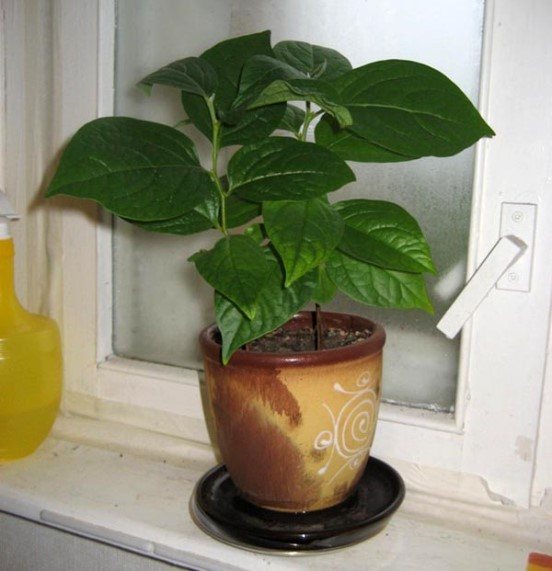

Proper care of homemade persimmon in a pot
Picking
If shoots have appeared, they begin to grow rapidly. Therefore, immediately remove the film that covered the container with seedlings. Place the sprouts in separate pots or cups as needed. This must be done before the roots grow and intertwine.
Advice: do not use large-volume containers for picking. It will be difficult for a small plant to immediately master the entire volume of the earth, and it may die. It is better to do several transfers as you grow into larger containers.
In the first years, the persimmon from the stone will grow so powerfully that it will have to be transplanted annually, sometimes even twice a year.
How to tell if it's time to replant a plant? The first sign is that it dries up very quickly.Second, the roots begin to look out of the holes in the bottom of the glass or pot, and the tips of the leaves often dry out.
After 5-6 years, you can transplant once every 2 years, not more often. When transplanting, especially in the first years of life, try not to disturb the delicate roots of the plant, use the transshipment method, not transplant. In this case, it will be easier for the plant to adapt, it will more easily transfer this process.
It is best to replant in spring or late autumn. The new container should be 4-6 cm larger than the previous one, no more.
Lighting
The main mistake that many make is when young plants are placed immediately in the bright sun, for example, on a window. Despite the fact that persimmon is a southern plant, delicate sprouts cannot withstand this. Therefore, it is necessary to accustom to the sun gradually, and at first to shade.
In general, persimmon loves bright, but diffused light, so you should not put it on a balcony or on a veranda in direct sunlight, or be sure to immediately shade the tree, protecting it from burns. If you want the plant to receive a sufficient amount of light, it is better to lengthen its daylight hours by several hours in the morning and evening due to additional lighting with a phytolamp.
How to feed properly
Another common mistake: feeding. Surprisingly, but it is in relation to persimmons with top dressing that you need to be extremely careful. Under natural conditions, it is used to growing on rather poor soils, so excessive fertilization can irrevocably destroy a young tree.
At the very beginning, you can feed with nitrogen fertilizers, and take half the fertilizer rate for a standard amount of water. In winter, when the plant is dormant, no fertilizing is needed. Even during active growth, they are fed no more often than once every 2-3 months, while it is recommended to alternate mineral and organic fertilizers.
If possible, replace organic fertilizers with a complex of effective microorganisms that will create a favorable microflora inside the pots. Always remember that underfeeding is better than overfeeding. Make this your basic rule of thumb when caring for persimmons.
Important! You can fertilize seedlings only after abundant watering, otherwise the delicate roots will simply "burn" and the plant will die.
Watering
Persimmon is a plant of the subtropics. Therefore, moisture is very important for her. It is necessary to water regularly, but so that there is no stagnation of water. In addition, the plant needs air humidity.
To provide the tree with comfortable conditions, you need it spray periodically warm water. It is better to do this in the evening, especially in late spring and summer. You can put a flat wide container with water next to the plants, the fumes from which will soften the air.
In winter, the plants are not sprayed, but rarely watered.
Crown formation
After the seedling has 4-5 leaves, pinch its growth point. This is necessary so that the plant forms lateral shoots, does not grow so quickly and remains as compact as possible. Usually, after such a procedure, the plant blooms for 3-4 years.
Periodically applying this method for all shoots, in a few years you will get a pretty low tree with a spherical crown, the height of which will mainly depend on your desire.
Subsequently, it will be necessary to periodically thin out the branches, avoiding excessive thickening of the crown. This will help not only to preserve the decorative appearance of the plant, but also will allow you to quickly achieve the desired result - to achieve flowering and grow tasty fruits.
Temperature regime
Young plants are quite sensitive and they need warmth, the optimal mode is + 22оС. When the plant has already formed, it feels great at a lower temperature, up to + 15 ° C.
A very important moment in the life of a plant is wintering. Without this stage, the tree will neither bloom nor bear fruit.Therefore, in the fall, gradually reduce watering and transfer the persimmon to a cool room with dim, diffused light.
During the dormant period, the plant sheds its leaves, there is no need to be afraid of this, this is a normal phenomenon, this is what happens in nature. The temperature in such a storage should not be higher than + 5 ° C, but it is also undesirable for it to fall below -5 ° C. A short-term drop to -10 ° C is possible, but it is very important that the roots do not freeze.
Watering is necessary only if the earthen lump is very dry, usually this once a month, not more often. Alternatively, for the winter period, you can simply mulch the surface of the earth with sawdust or peat. The room should be ventilated, it should not be too damp, excessive humidity can provoke the appearance of mold.
Germinating persimmon seeds
Fruits that have reached maturity while on the tree are most suitable for harvesting seeds. This usually refers to the period of late autumn and early winter. In the case of using purchased persimmon fruits for sowing, you need to choose the most mature specimens. After removing the seeds, they must be washed from the pulp using a colander.
Persimmon seeds need stratification, i.e. it is necessary to recreate the natural conditions for storing seeds in the winter. Their storage should be carried out at a temperature of about 5 degrees Celsius in a humid environment for two to three months, this will allow the shell of the seeds to soften and prepare the seed for germination. For stratification, wet sand or peat is usually used, between the layers of which persimmon seeds are placed.
To germinate seedlings of persimmon trees, you need to use medium-sized pots with well-drained soil, which is a mixture of peat and garden soil. The persimmon seed must be buried to a depth equal to the length of the seed itself. It is important at the stage of germination and growing of persimmons to keep the soil constantly moist and warm. A temperature of 22 degrees Celsius stimulates well the germination process of the tree.
One to six weeks after planting, a persimmon sprout with the first pair of leaves should appear. It is advisable to plant several persimmon seeds at once in order to select the strongest trees in the future. During the rearing period, it is necessary to provide the plant with maximum access to sunlight. In the future, when planting in a garden or when growing persimmons at home, you need to provide for an open sunny place for it to locate the tree on a permanent basis.
Seed processing
Having chosen the appropriate grains for sowing, whole and intact, they should be prepared. First, the juice is washed off. Then immerse yourself in life-giving moisture for a few minutes. The floating ones are thrown away, the rest are dried on a napkin.
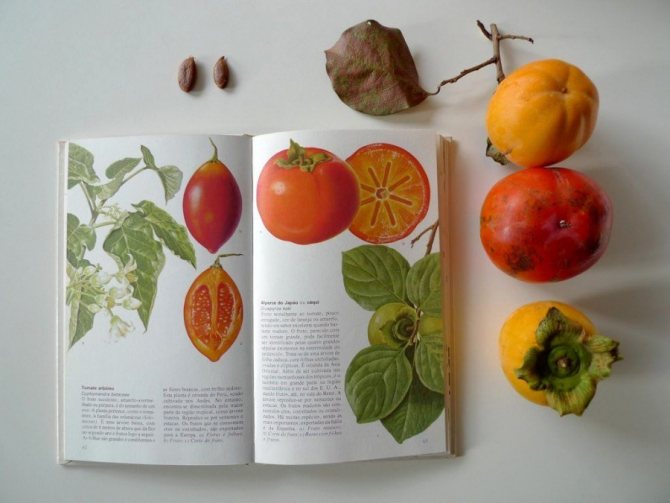

Disinfection affects the successful germination of the seedling. After washing, dip the seeds in a weak manganese solution for a day. To speed up pecking, gently walk over the ribs with a soft emery paper or glass nail file.


Pest control


False-scale larvae
Persimmons are rarely attacked by pests. Infection is possible with insects such as a false shield. The larvae drain the seedlings because eat juice. Damaged leaves lose their color and dry out over time. For preventive purposes, it is necessary to treat with special chemicals twice a year.
The spider mite infects the ground parts of the plant. It’s hard to get him out, but it’s possible. If you don't take action, the tree will die. It is important to treat the soil before transplanting to get rid of the larvae. The larvae of the beetle can settle in the trunk. At home, this pest practically does not occur, as well as the fruit fly. Therefore, no special measures are required, the main thing is to provide proper care and timely watering.
Why is it useful to grow such a fruit crop
Persimmon wins in comparison with other fruits, both in nutritional aspect and in terms of external beauty throughout the whole year. First, a beautiful flowering, then luscious green foliage, which in autumn is replaced by various shades of yellow and red. And after the leaves have fallen off, the tree is ready to give its fruits, which stay on the trees for 1.5-2 months. At the same time, the taste characteristics of the product are preserved. Persimmons are good both fresh and dried. From persimmon, delicious confitures and syrups, jellies and marmalade are obtained.
(read more ...) :: (at the beginning of the article)
Table of Contents :: Search
Unfortunately, errors are periodically encountered in the articles, they are corrected, the articles are supplemented, developed, new ones are being prepared. Subscribe to the news to keep up to date.
If something is not clear, be sure to ask! Ask a Question. Discussion of the article.
More articles
Blackleg. Rotting, softening of the tissue of the stem (trunk). Signs, with ... Black leg - rots, the stem softens. How to identify a disease and cure ...
Ziziphus - reproduction, care, fertilization, soil fertilization. Agrotechnologists ... Ziziphus - How to prepare soil, multiply, fertilize, feed. How does it endure ...
Knitting. Fern leaves. Openwork dolls. Drawings. Patterns ... How to knit the following patterns: Fern leaves. Openwork dolls. Detailed and ...
Knitting. Ways, methods of a set of loops. How to put on loops? ... Knitting - Overview of ways to set loops ...
Growing marjoram - planting tips.
Treatment of diseases


Powdery mildew on persimmon leaves
A tree at home, grown from a stone, is exposed only to powdery mildew infection. For preventive purposes, it is necessary to take the plant out into fresh air. To fight, it is necessary to treat persimmon with fungicides.
Other problems:
- Yellowing of the leaves is a sign of excess moisture in the soil. Watering should be reduced so that the root system does not rot. In this case, it is very difficult to save the plant.
- Ovaries may be missing due to insufficient feeding. Fertilizers should be added to the soil regularly. It is important to adhere to the scheme so as not to harm the young seedlings.
- Seedling leaves begin to shed when climatic conditions change. If persimmon is placed in a draft or drastically change the temperature regime, you can seriously harm.
- Growth stops if the root system is cramped. Balance is important. Persimmons do not require too much space, but stressful situations should be avoided.
- Lack of seedlings can be the result of poor planting material. Not all seeds are suitable for germination. It is important to pick up a ripe mother fetus.
Lighting
The first blades appear around the month. They will require more diffused light, but not scorching rays.
If the tank is on the south side, it is useful to cover the window with a white sheet of paper. This will result in a shaded atmosphere. Flowing influences also have a detrimental effect on the sprouts.
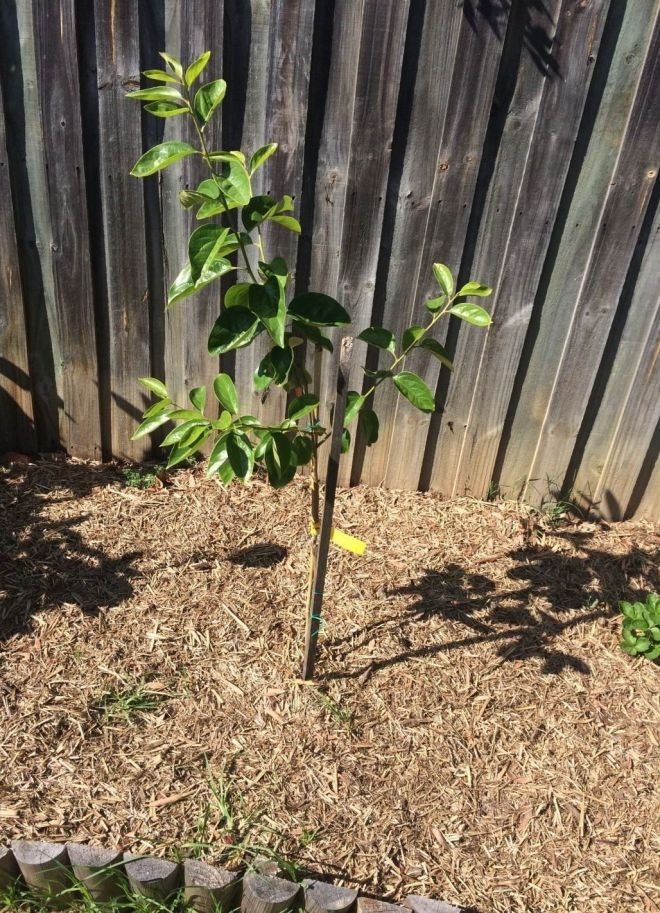

According to the rules of care, it is important for seedlings to gradually get used to the light. But it is impossible without it at all, this will bring the plant to illness and zero fruiting.
- In summer weather, take out to the balcony.
- In winter, arrange a lighting addition by artificial means.
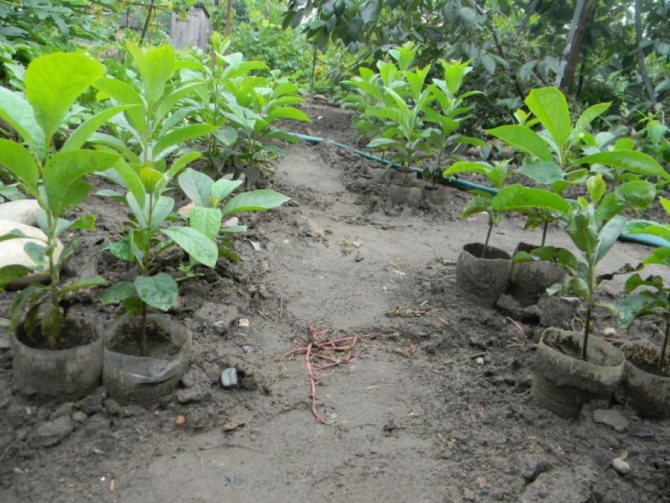

Landing
Let's consider the planting process in more detail. First, let's prepare the soil for the persimmon. We take peat, coarse river sand and light fertile soil in equal parts. Sand can be replaced with fine perlite. The acidity of the soil should be neutral.
If necessary, you can add a little dolomite flour or ash. We mix everything, if possible - add "Baikal EM-1" or phytosporin, moisturize and cover so that sunlight does not penetrate there.
We put it in a secluded place for 7-8 days. During this time, microorganisms are activated, and the soil "ripens" - it becomes soft, crumbly and moderately moist.
Option 1
If there are a lot of seeds, then you can plant them first in a common container, cover with plastic wrap or glass and put in a warm place. From time to time it is necessary to remove the film (glass), allowing future sprouts to breathe fresh air, otherwise they may become moldy. Persimmon seeds are planted "on the edge", deepening no more than a couple of centimeters.
The optimal distance between them is 3-4 cm, then later the seedlings will be easy to plant.
Option 2
You can plant the seeds directly in small containers. To do this, they usually take disposable plastic cups, from which it is imperative to make holes in the bottom to drain excess water. At the bottom, it is necessary to put drainage (small expanded clay or large perlite).
The best germination temperature is from + 22 ° C to + 24 ° C. You can put a container with seedlings on a windowsill or near a central heating battery, but you must make sure that the earth does not dry out. An excess of moisture is also dangerous, because then the bones can simply rot. The soil should be moistened sparingly as needed, preferably by spraying it with warm water.
Usually, the first shoots appear after 28-30 days. If this does not happen, sowing should be repeated, but at the same time use a different seed.
Often, on top of the seedling, after it has begun to grow, a dense leathery shell remains from the bone. To remove it, take a piece of gauze or a small piece of cotton wool, moisten it and place it gently on top of the sprout, cover it with a plastic bag.
After 10-12 hours, the casing will soften and can be easily removed. Do this as carefully as possible, holding the persimmon sprout and being careful not to damage it.
Watch the video for a detailed shell removal process:


